|
|
Welcome to the late-Winter / Spring 2018-19 long overdue edition of the Hung Liu Studio Newsletter (#21). Please enjoy looking through it! Also, check out Hung's website.
|
|
|
(c) Michael Brennan, San Francisco
|
|
|
|
SFMOMA Acquires Hung Liu's "Secret Freedom" Paintings
|
H
ung Liu Studio is very pleased to announce that the San Francisco Museum of Modern Art has acquired 38 of Hung's "Secret Freedom Paintings," which she painted daily & secretly in the rural outskirts of Beijing in the early 1970s. Although she painted over 300 of them, only these remain. Senior Curator Gary Garrels recognized the daring, courageous attempt, day after day, to move furtively through the political hysteria of the Cultural Revolution, resisting the expectation to paint propaganda in the service of the state. By contrast, the artist painted no people or heroic scenes in her diminutive canvases (carried beneath her coat in a tiny paint box), choosing instead to paint intimate, vernacular landscapes that were full of feeling for China but emptied of the pseudo passions of nationalism.
With this major acquisition, the museum acknowledges the historical importance of these expressions of the artists's secret freedoms.
|
Theater of the World: Art and China after 1989
San Francisco Museum of Modern Art
San Francisco, CA
November 10, 2018 - February 24, 2019
Bracketed by the end of the student protests in Tiananmen Square in 1989 and the Beijing Olympics in 2008,
Art and China after 1989: Theater of the World
presents works by more than sixty artists and artists' groups that anticipated, chronicled, and agitated for the sweeping social transformation that saw the rise of China as a global power in the new millennium. The exhibition examines conceptually based performances, paintings, photographs, installations, videos, and socially engaged projects that question consumerism, authoritarianism, and the rapid development transforming society and China's role in the world, placing their experiments firmly in a global art-historical context. The artists serve as both skeptics of and catalysts for the massive changes unfolding around them, and their work continues to inspire new thinking at a moment when questions of identity, equality, ideology, and control have pressing relevance. - SFMOMA
Organized and curated by the Guggenheim Museum, New York, this show also travelled to Bilbao and then to SFMOMA. At this final venue Hung' work was displayed - specifically, the well-known self-portrait of the artist in the Chinese army in 1972, "Avant-Garde" (
collection of the San Jose Museum of Art). A special thanks to Gary Garrels, Alexandra Munroe, and Phil Tinari.

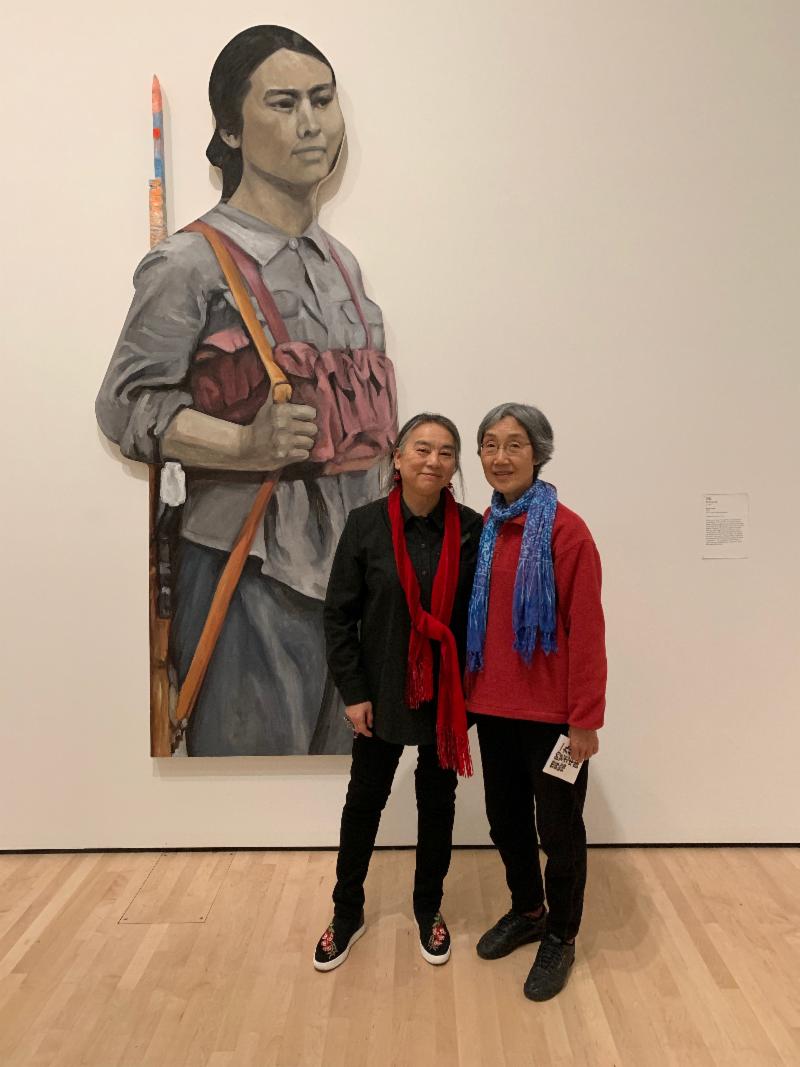 Panel discussion with curators and artists, SFMOMA - Hung in front of her painting with her 50-year long best friend, Chen Bing
Panel discussion with curators and artists, SFMOMA - Hung in front of her painting with her 50-year long best friend, Chen Bing
|
|
|
I
n the green room with Phil Tinari, Director, UCCA, Beijing
|
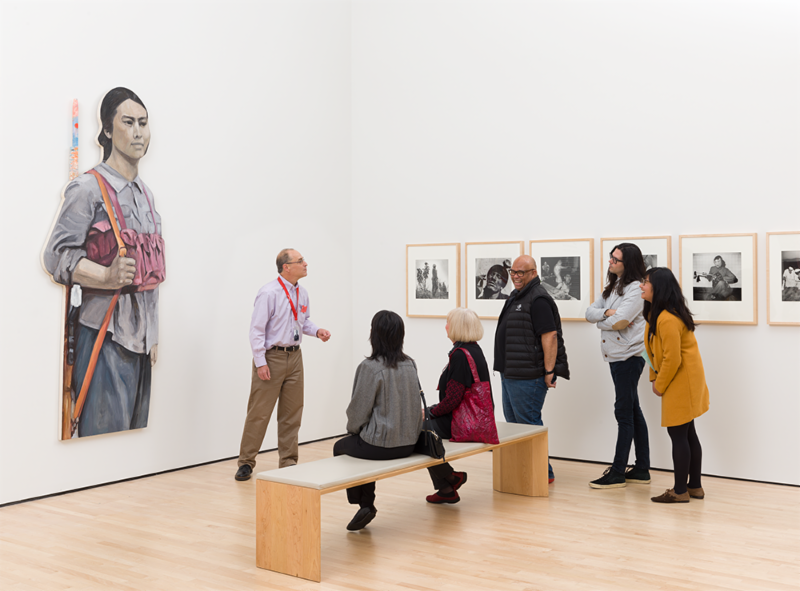
Hung Liu: Migrant Stories
près Dorothea Lange and Depression-Era Photography, 1933-1942
Wichita Art Museum
Wichita, Kansas
March 2 - August 18, 2019
Hung Liu: Migrant Stories features paintings and prints by Hung Liu. Based on the iconic photographs of Dust Bowl and Depression-era photographer Dorothea Lange, Liu's works depict families and children devastated by the Great Depression of the 1930s. This small show accompanies and supplements a much larger exhibition of Lang's photographs.
|
|
|
With Curator Tara Hedrick & Kansas City gallery owner Sherry Leedy
|
|
|
|
With Jennifer Bowerman, museum director Patricia McDonald, and Tara Hedrick
|
|
|
|
At the Ambassador Hotel, Wichita, with Jennifer Bowerman, Sherry Leedy (Jennifer's mom), Toma Wolff & Amanda Sherer
|
|
|
 |
| At Frank Lloyd Wright's "Allen House," in Wichita |
 |
Present Tense: Task of
Remembrance
Chinese Cultural Center
San Francisco Chinatown
April 27 - December 21, 2019
|
|
 |
"Chinese Pieta," plywood, ink, and acrylic, 1989
|
 |
The C
hinese Culture Center (CCC) presents the latest iteration of its
Present Tense Series
with a group art exhibition that reflects on the complexity, gravity, and responsibility of remembering. Marking the thirtieth year since the global, cultural, and political upheavals of 1989, including the student protests in Tiananmen Square, the Loma Prieta Earthquake, and the fall of the Berlin Wall,
Present Tense 2019: Task of Remembrance
looks broadly at struggles for freedom, the weight of history, and the ways artists and their communities build and engage with memory.
Working in a variety of media from sculptural installation to experimental film, participating artists, art collectives, and arts organization include the Asian American Arts Centre, Sofía Córdova, Yan Jun, Hung Liu, Ming Mur-Ray, Lam Tung-pang, Related Tactics, Xu Tan, Tina Takemoto, Jenifer Wofford, Gao Xia, Li Xiaofei, Wu Yuren, and Stella Zhang. - CCC
"Chinese Pieta" is one of a number of ink drawings on plywood cut-outs Hung did while living in Texas in the late-80s. These gave rise a few years later to the many shaped canvases for which she became known in the early 1990s.
|
Hallie Ford Museum of Art Lecture
Willamette University
Salem, Oregon
November 1, 2018
"Lecture with Artist ------> Hung Liu," with John Olbrantz, Museum Director
|
|
| In Eugene - "What'll it be pal?" |
Celebrating Fifty Years
National Portrait Gallery
Washington, DC
November 10, 2018
|
|
|
With Kim Sajet, Director, National Portrait Gallery
|
|
|
|
With Amy Sherald (who painted Michelle Obama's portrait)
|
|
|
|
With Dorothy Moss, Curator, NPG
|
|
|
|
With Mother Jones' & MSNBC's David Corn
|
|
|
|
With Kate Capshaw & Dorothy Moss
|
SFMOMA Lecture
San Francisco Museum of Modern Art
San Francisco, California
January 17, 2019
A
s p
art of a lecture series at the museum focusing on contemporary Chinese art, in association with the exhibition "Theater of the World: Art and China After 1989," Hung talked about her experiences living in China under the repression of the Cultural Revolution.
Hung discussing her experience as an artist in Communist China
Studio Lecture Series: Hung Liu - Stanford Arts
Stanford University
Palo Alto, CA
February 21, 2019
|
|
|
With Li Jianshen, Xie Xiaoze, Walter Maciel, Livin Yin, Gail Wight, Camille Utterback, Enrique Chagoya and Jeff Kelley after Hung's lecture at Stanford
|
At the Gates of Hell, Auguste Rodin, the Cantor Center, Stanford University
Communitas Lecture Series: Hung Liu
Caine College of the Arts, Utah State University
Logan, Utah
March 7, 2019
At the Nora Eccles Museum of Art with a wonderful Jay Defeo, and with Jane Catlin, Professor of Art
150 Year Transcontinental Railroad Commemoration
Panel Discussion & Ceremony:
Hung Liu & Zhi Lin
Nevada Museum of Art
Reno, Nevada
May 10, 2019
Artists Zhi Lin and Hung Liu joined Senior Curator and Deputy Director Ann Wolfe to discuss the sacrifices of Chinese Railroad workers who raced to complete the rail line that would unite America from east to west in 1869. Following their remarks, a ceremonial gathering took place at the exact time 150 years ago that the Golden Spike was hammered into the last rail at Promontory, Utah by Leland Stanford. Liu and Zhi then recited of the names of over 800 known Chinese railroad workers between 2:27 pm and 2:47 pm - a twenty minute period during which the original telegram announcing the completion of the railroad was sent from Utah to Washington DC in 1869. This somber, contemplative recitation was accompanied by the playing of traditional Chinese instruments by Todd Green, as the
audience gazed westward at the vast Sierra Nevada through which the Chinese workers cut the tunnels and beds of the Union Pacific.
Zhi Lin:
Chinese Railroad Workers of the
Sierra Nevada
Nevada Museum of Art
Reno, Nevada
May 4 - November 10, 2019
This staged film by Zhi Lin, taken from the artist's own painting, depicts a re-enactment of the famous "Golden Spike" moment from 1869, but from behind, where, as the artist imagines, the Chinese workers would have been standing out of sight. Although hundreds of Chinese were present on that historic day, none were allowed to appear in the photograph, so Zhi Lin's perspective here is that of the ghosts of history. A slow motion looping of the "toast" contributes to a mesmerizing film and an evocative memorial to the workers who helped unite America but were rendered invisible.
https://art.washington.edu/people/zhi-lin
|
|
New Member, Board of Trustees
San Jose Museum of Art
|
|
|
|
|
With Peter Lipman after the first board meeting of the season
|
|
|
 |
|
With members after the final board meeting of the season
|
 |
|
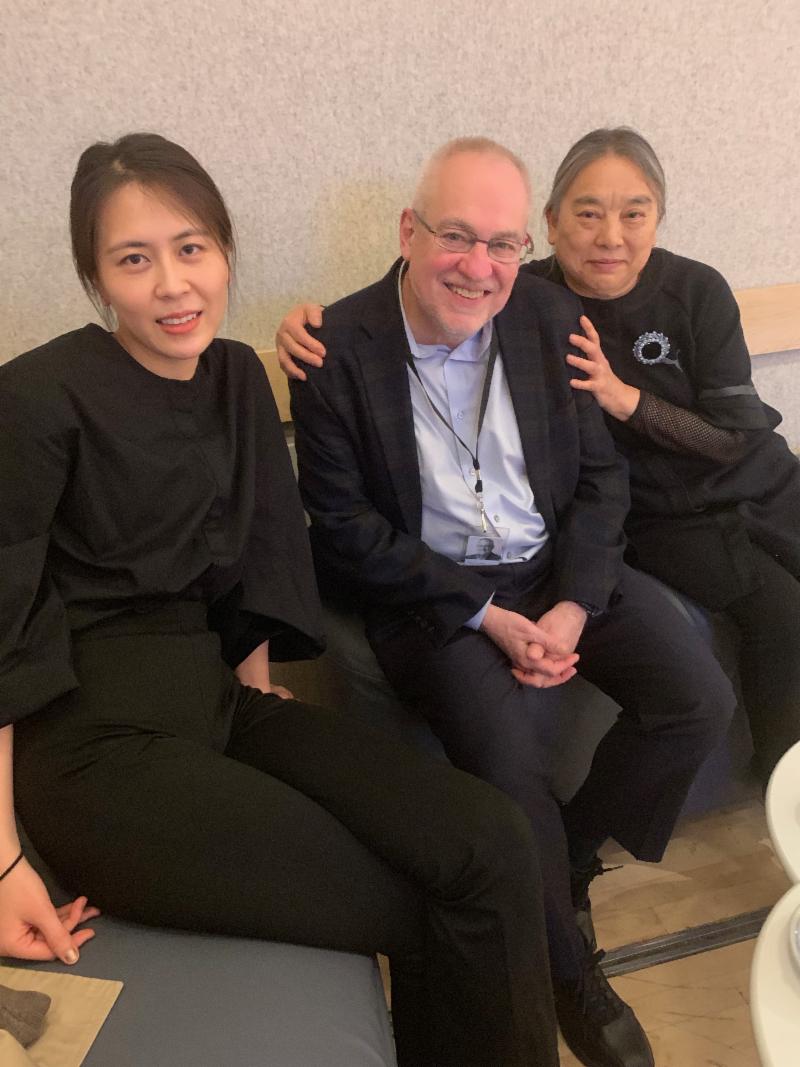 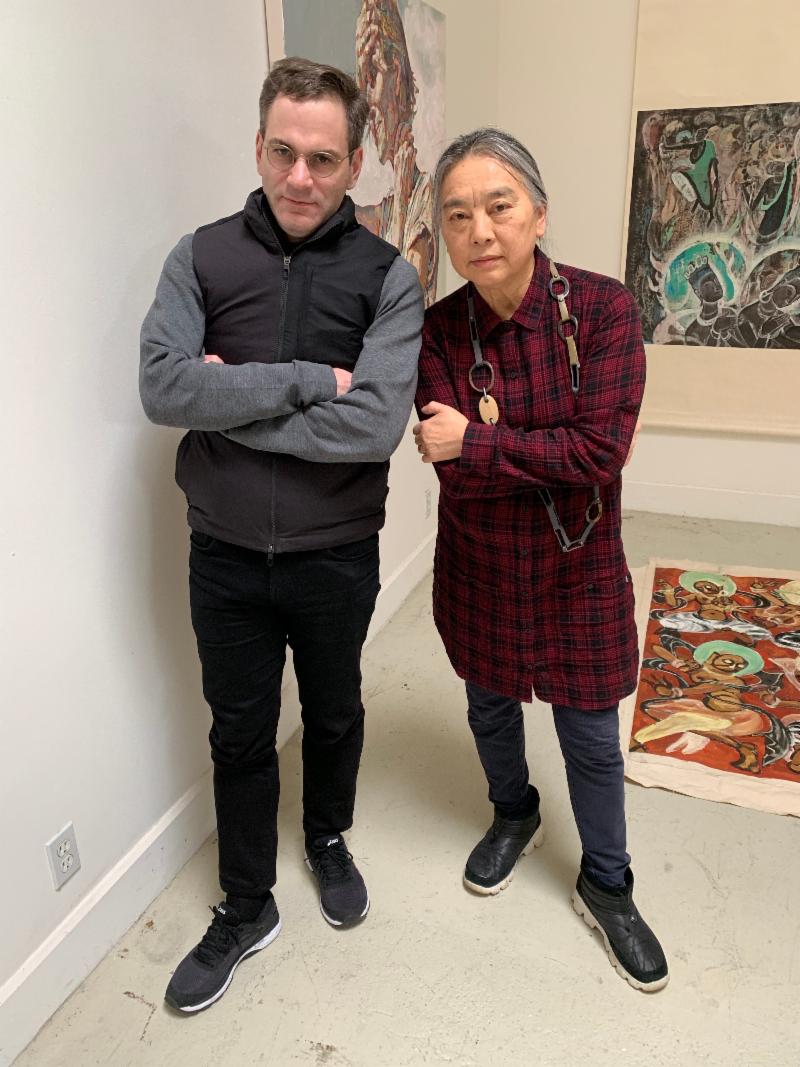
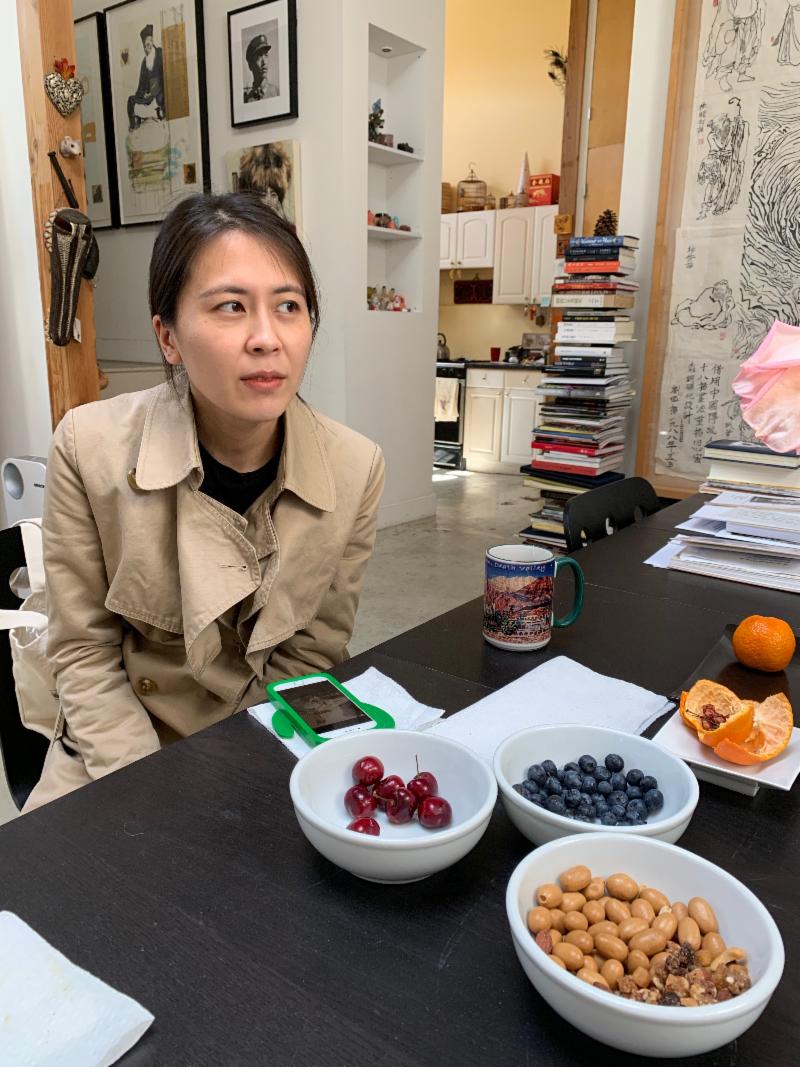 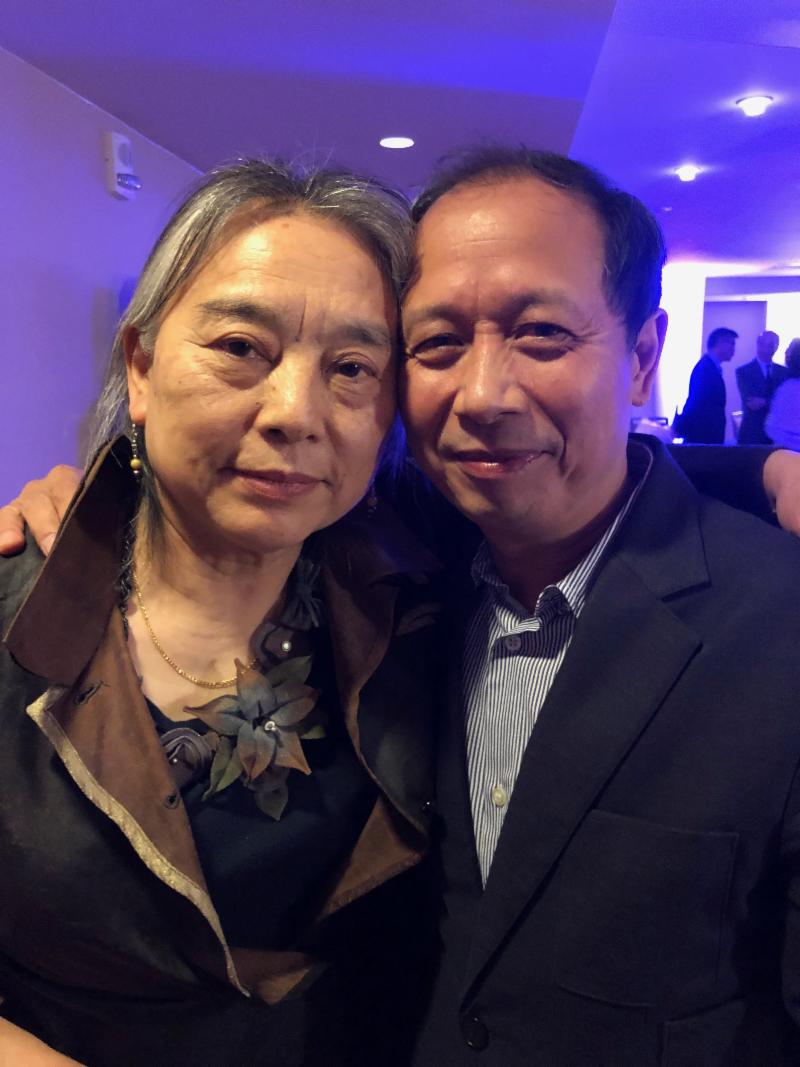
 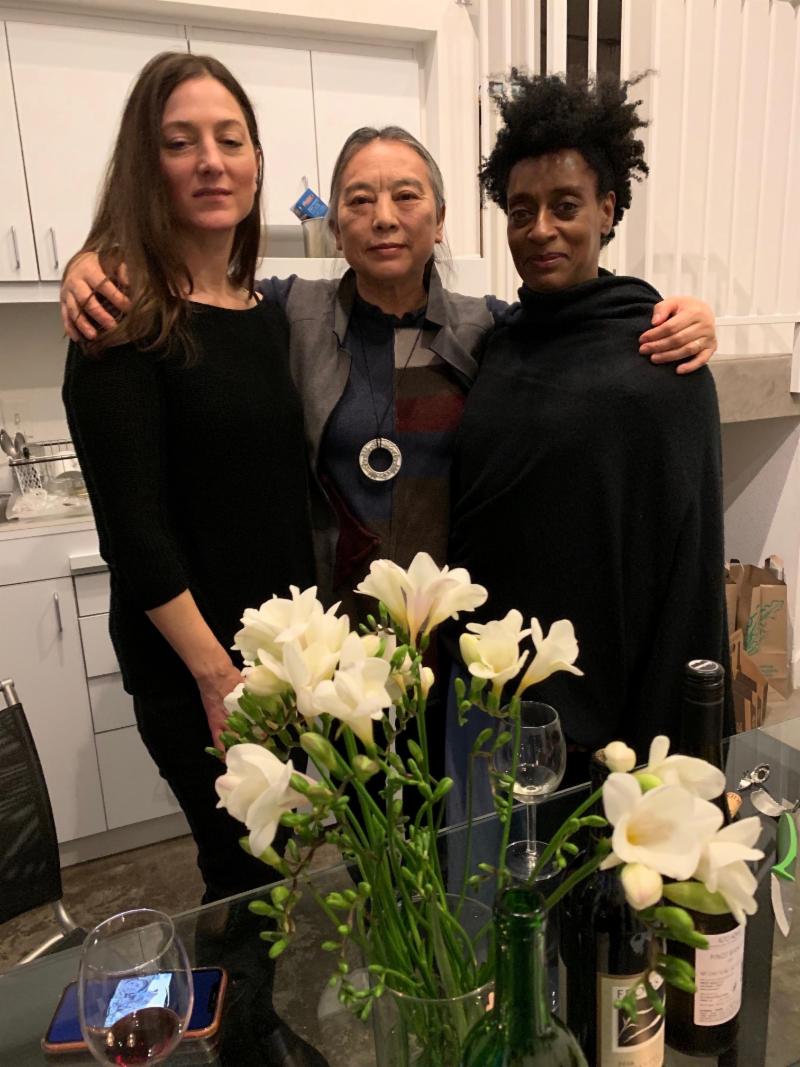
 
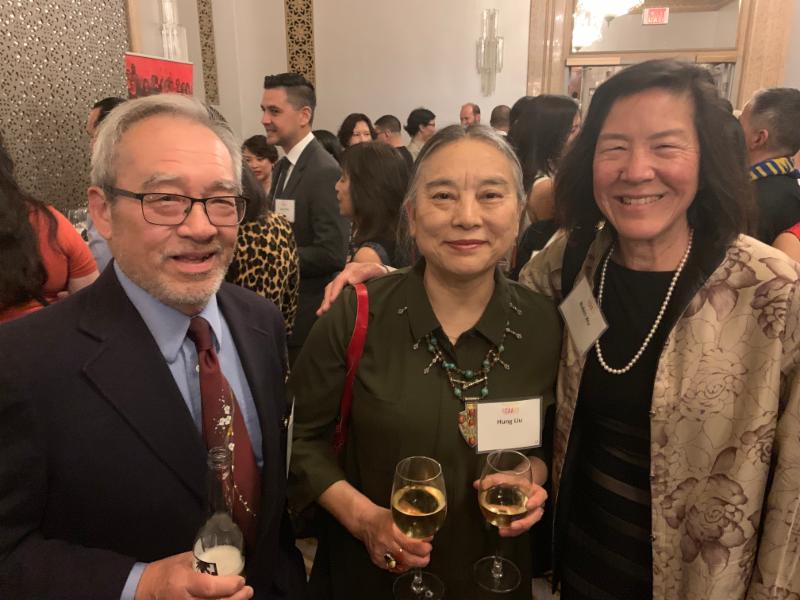 
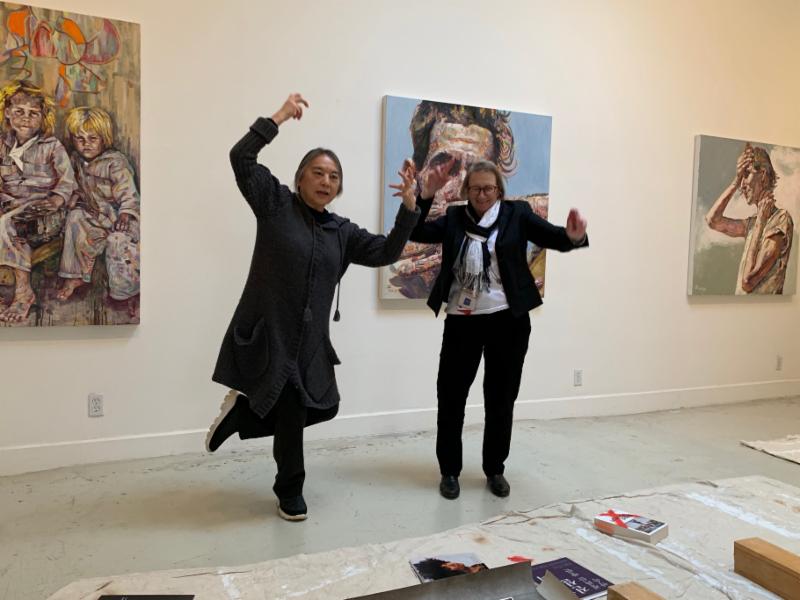 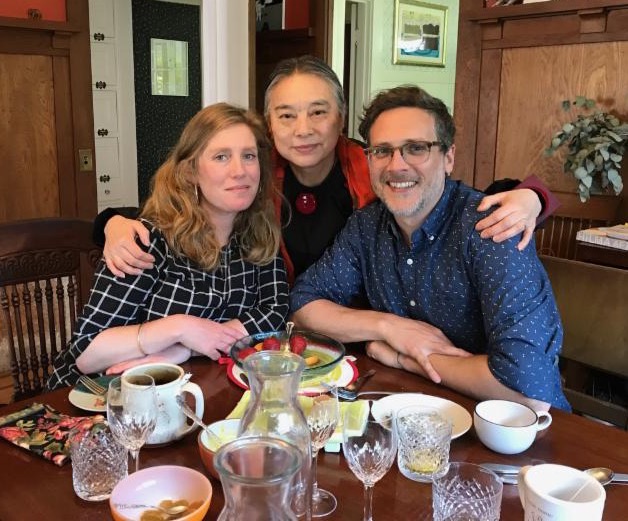
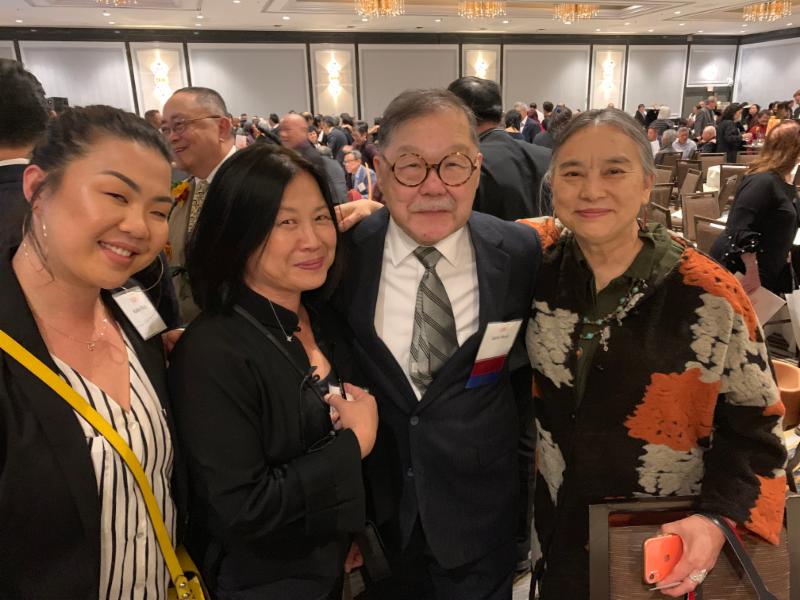 
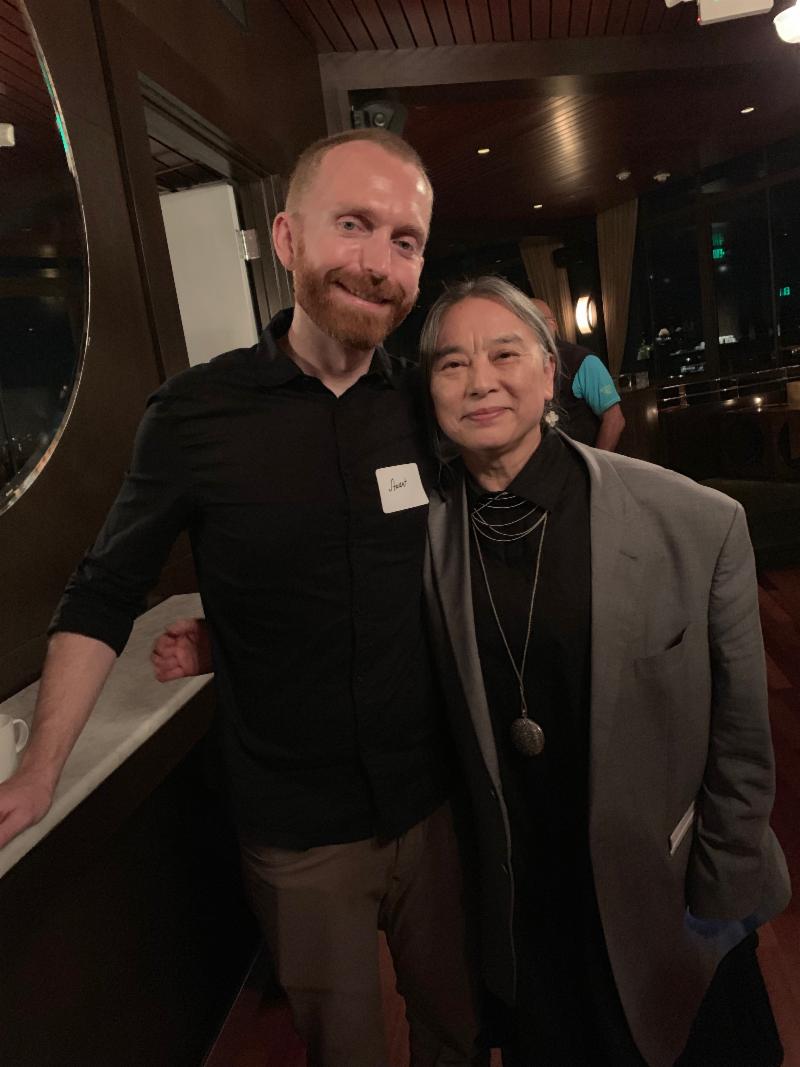 
 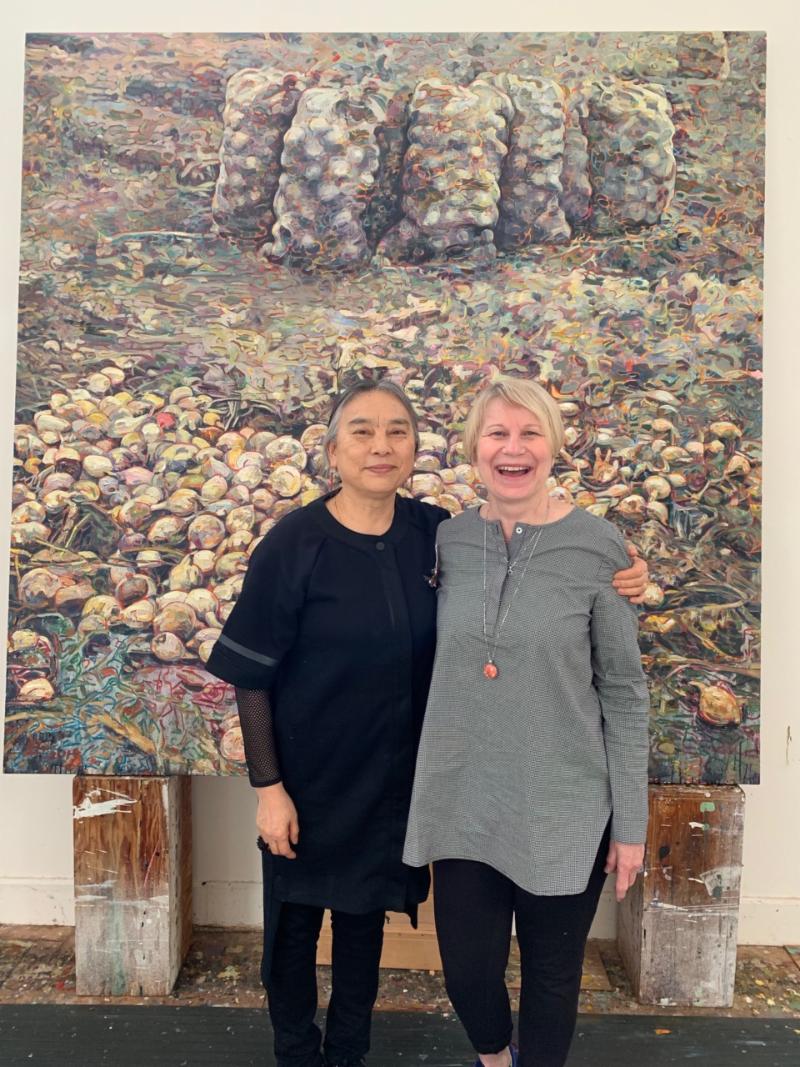
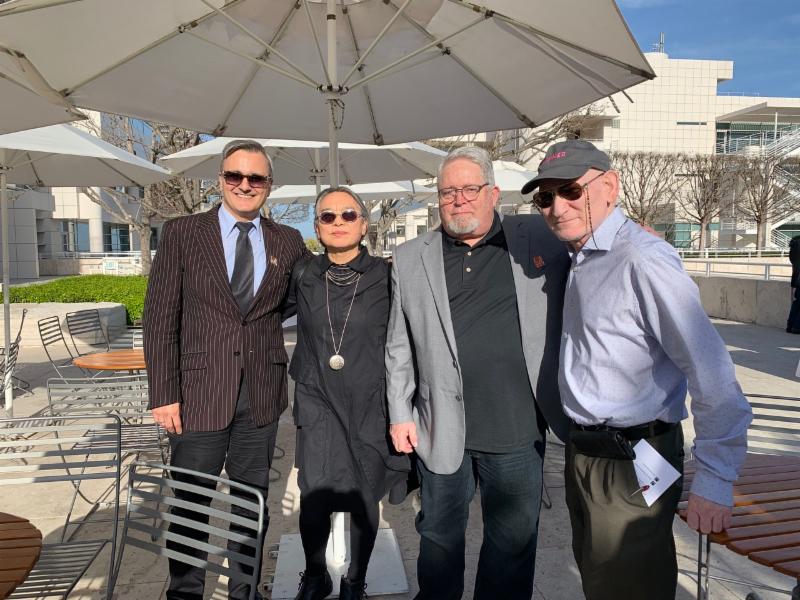 
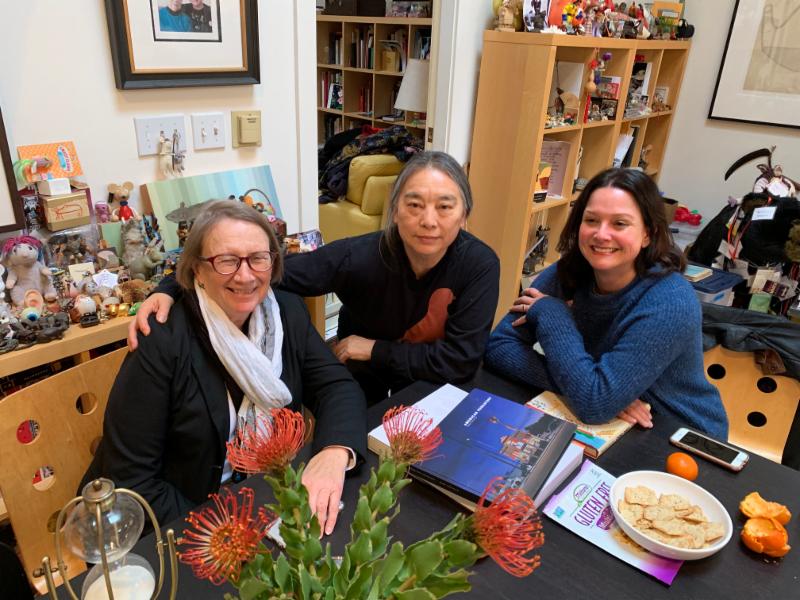 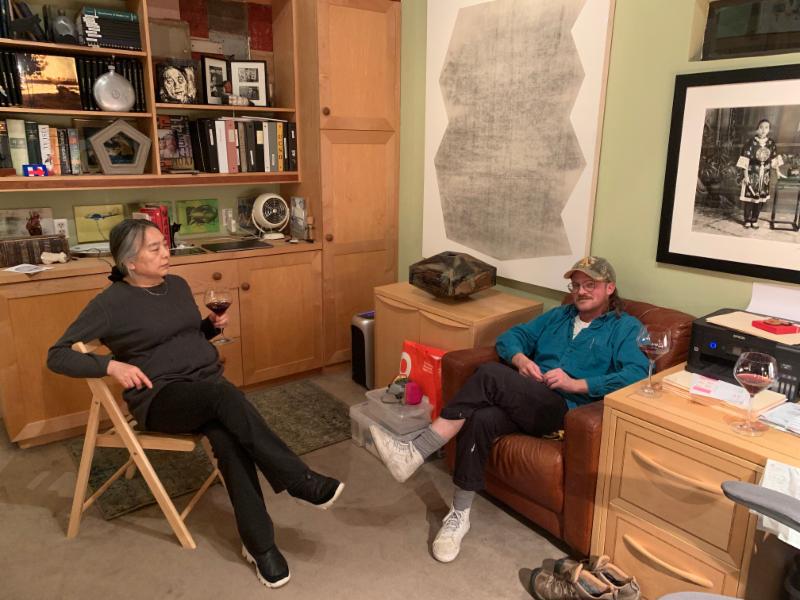
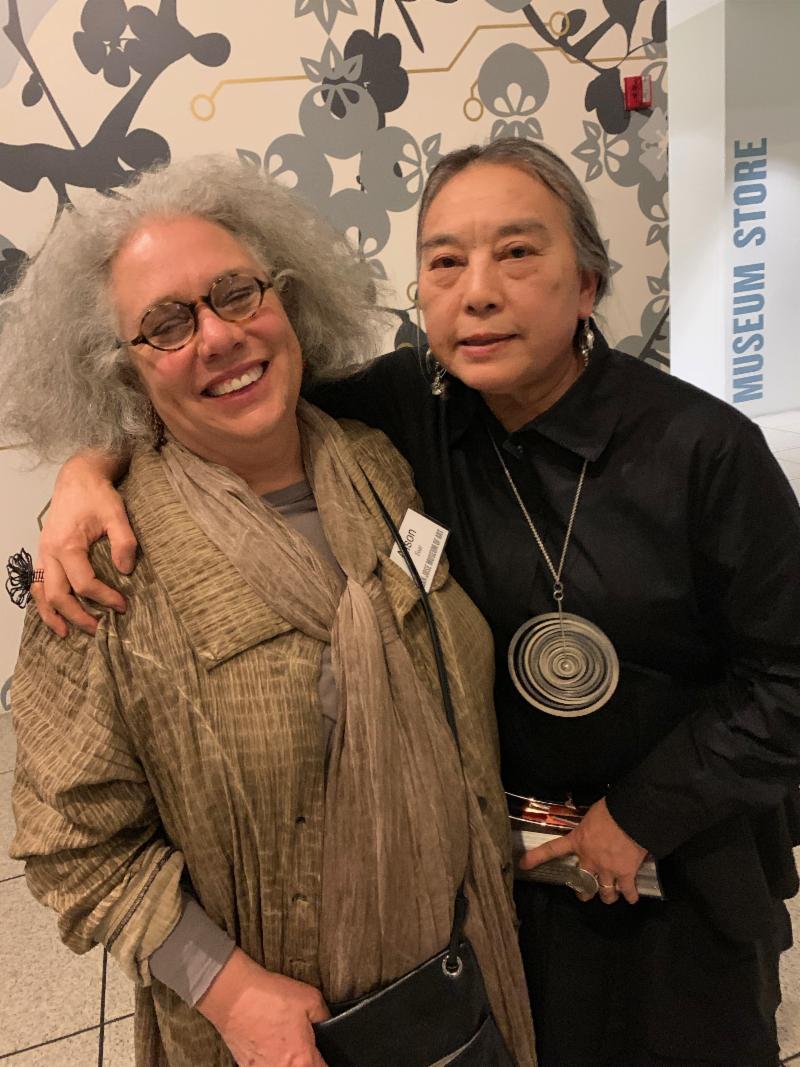 
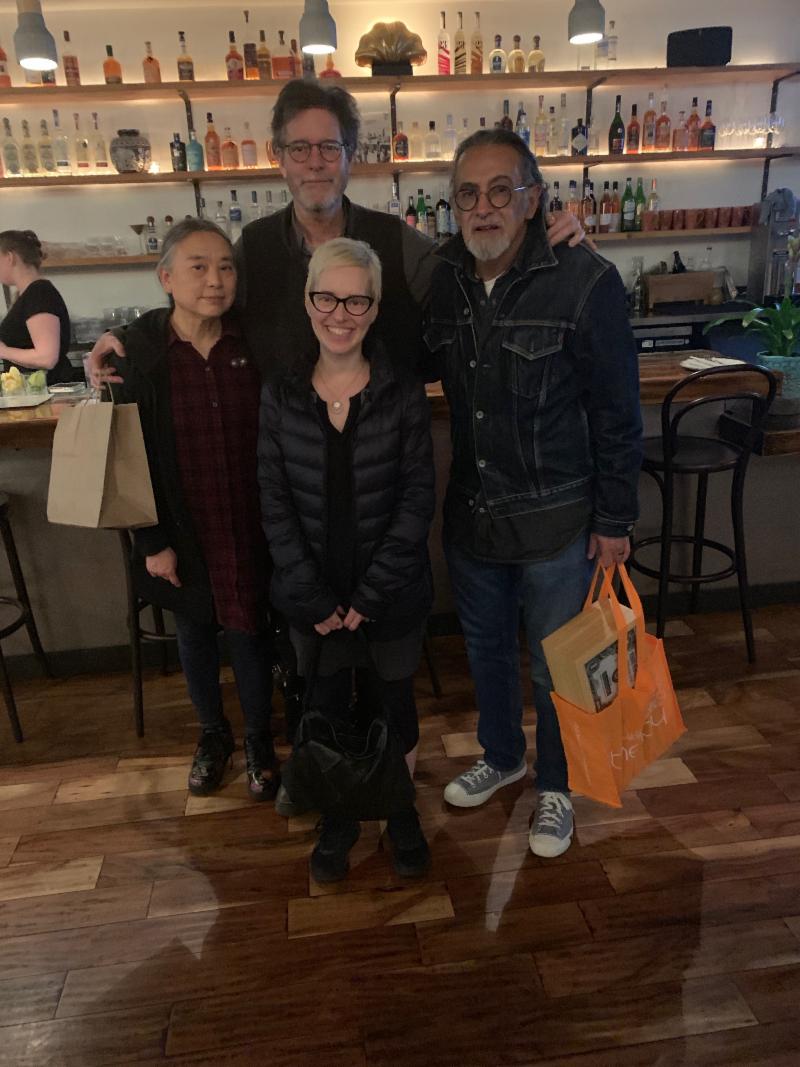 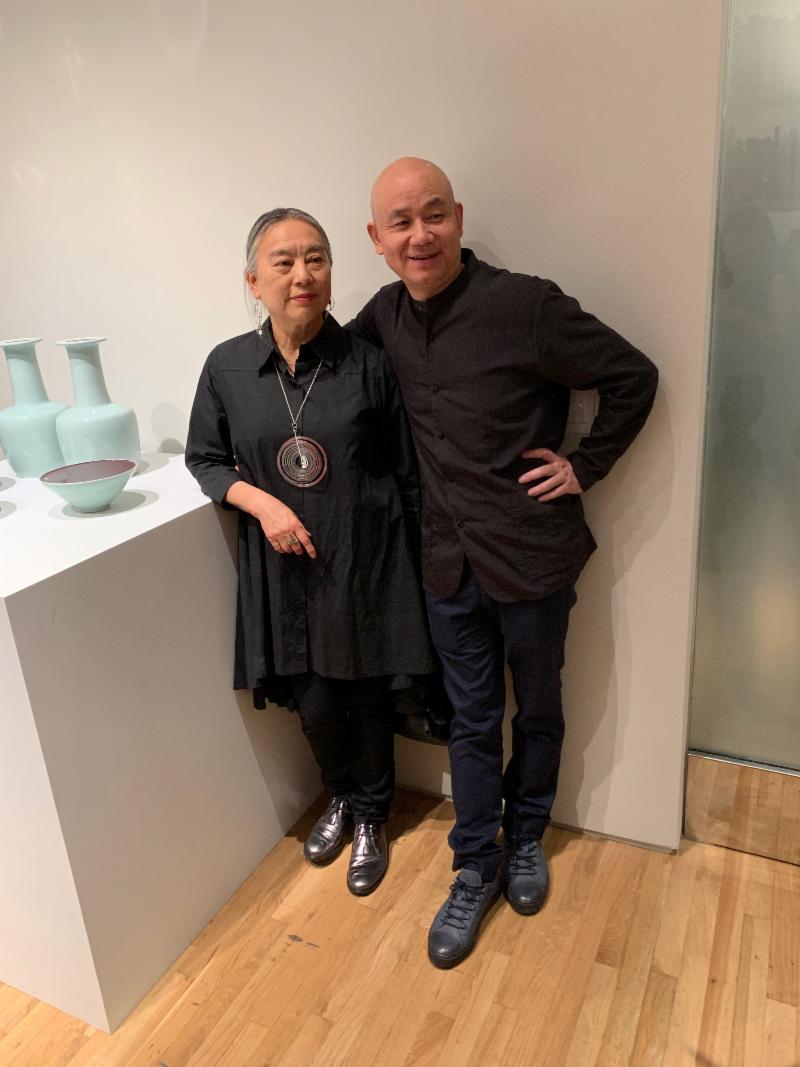
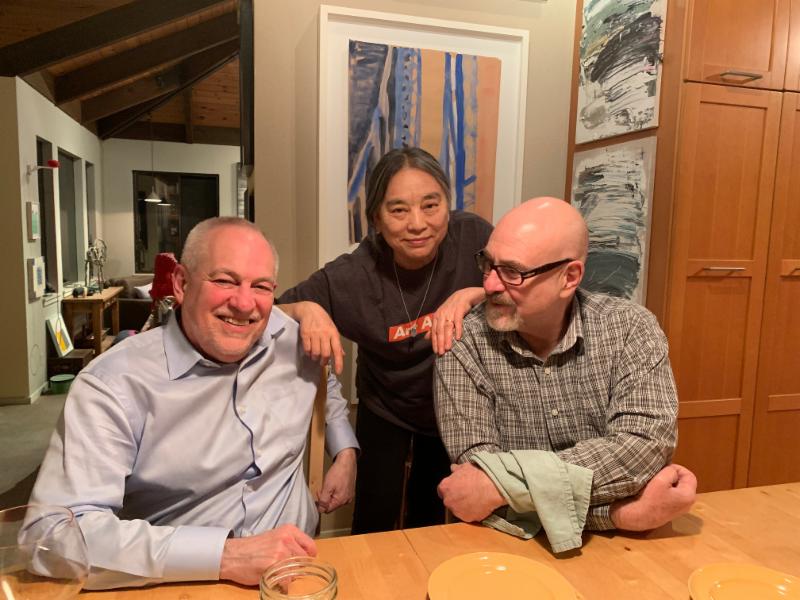 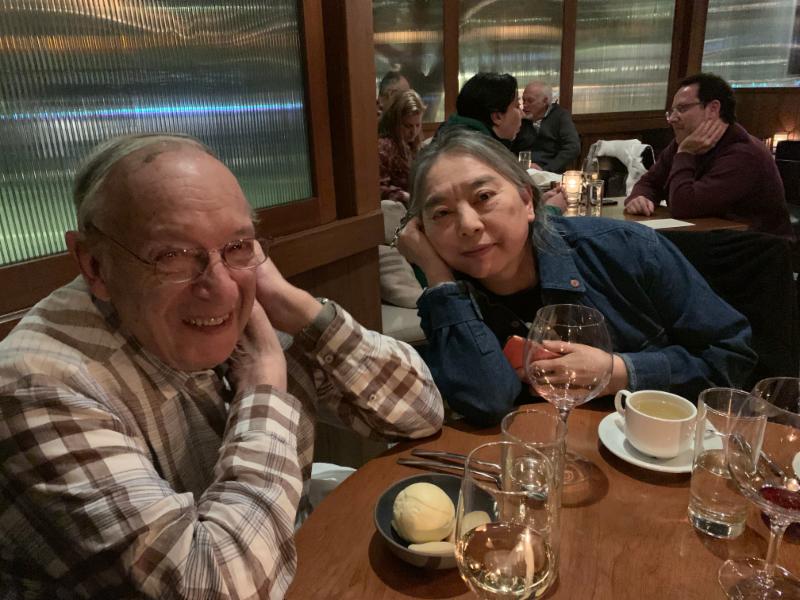
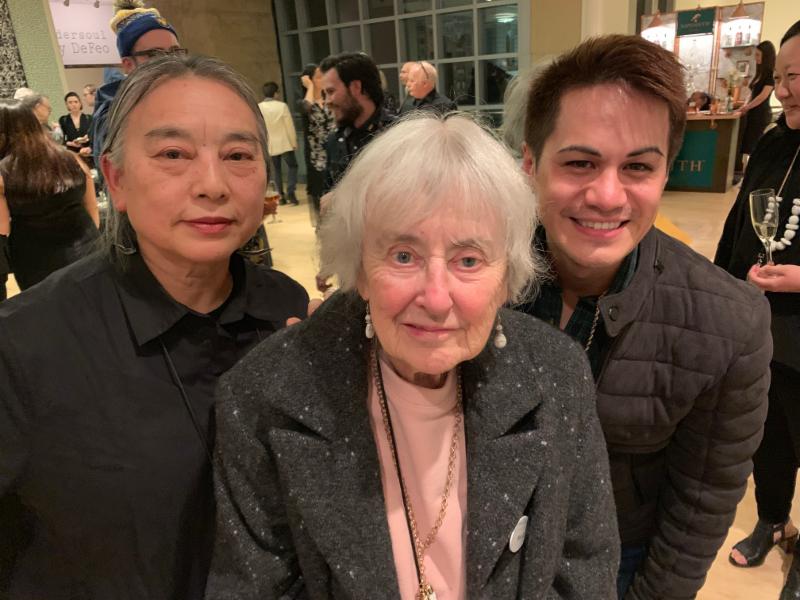 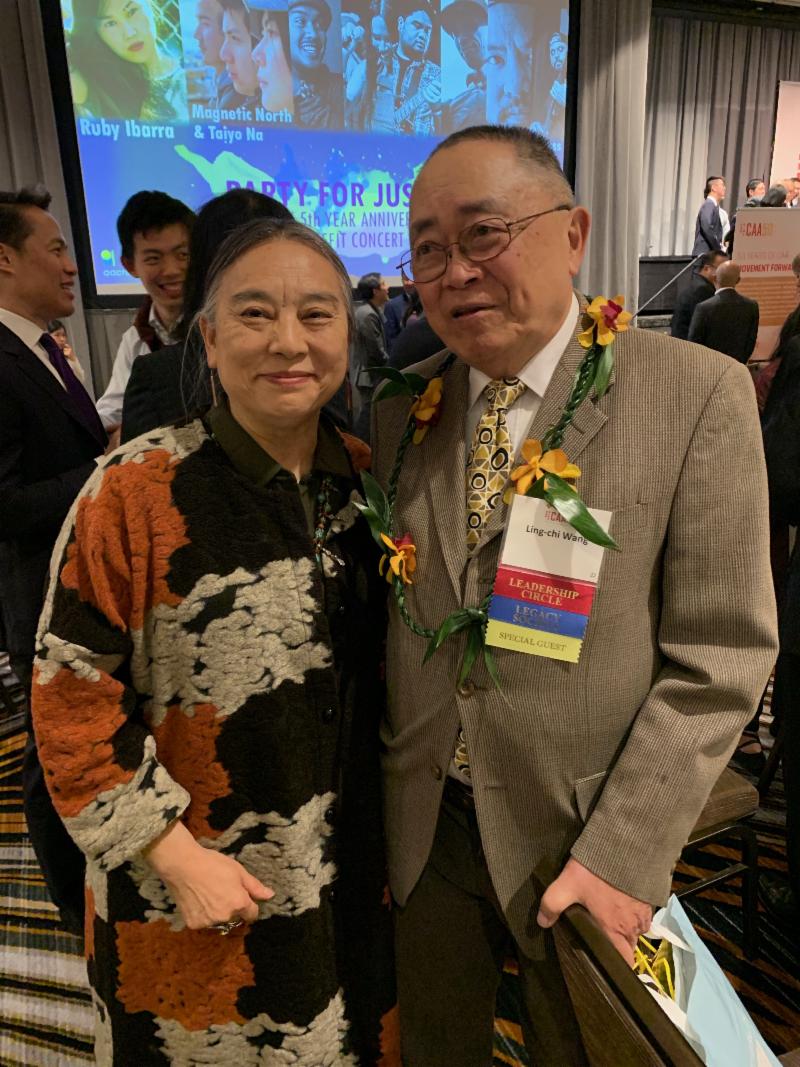
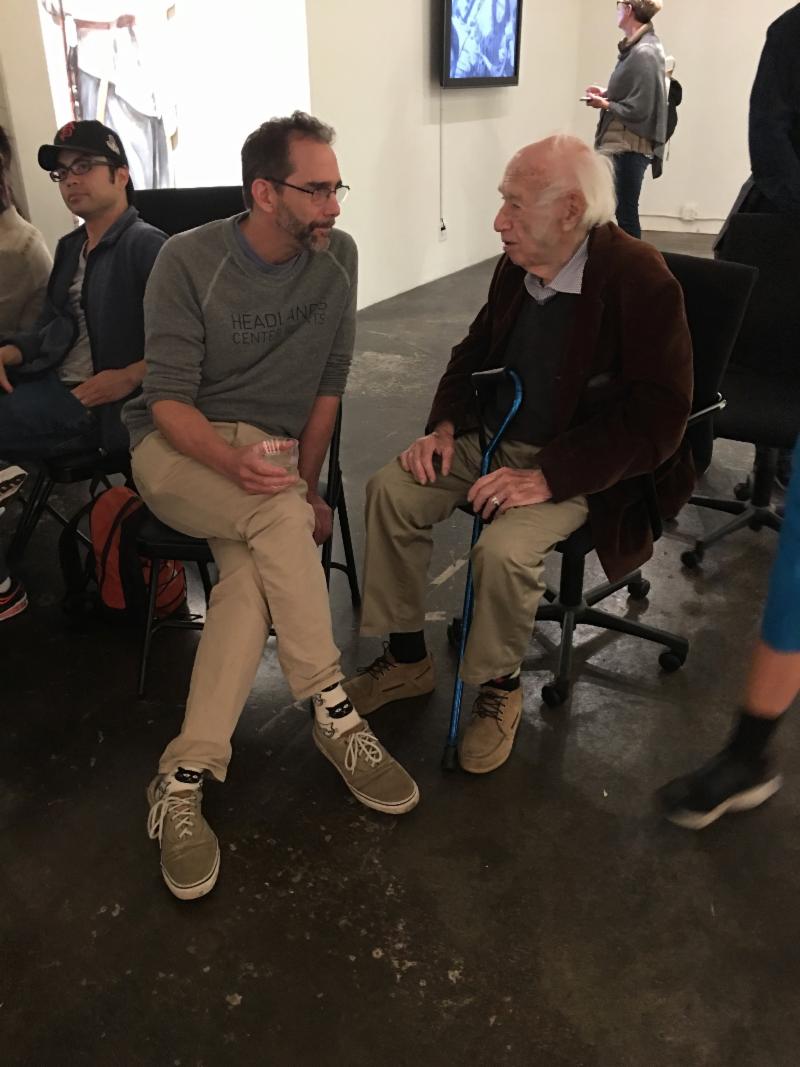 
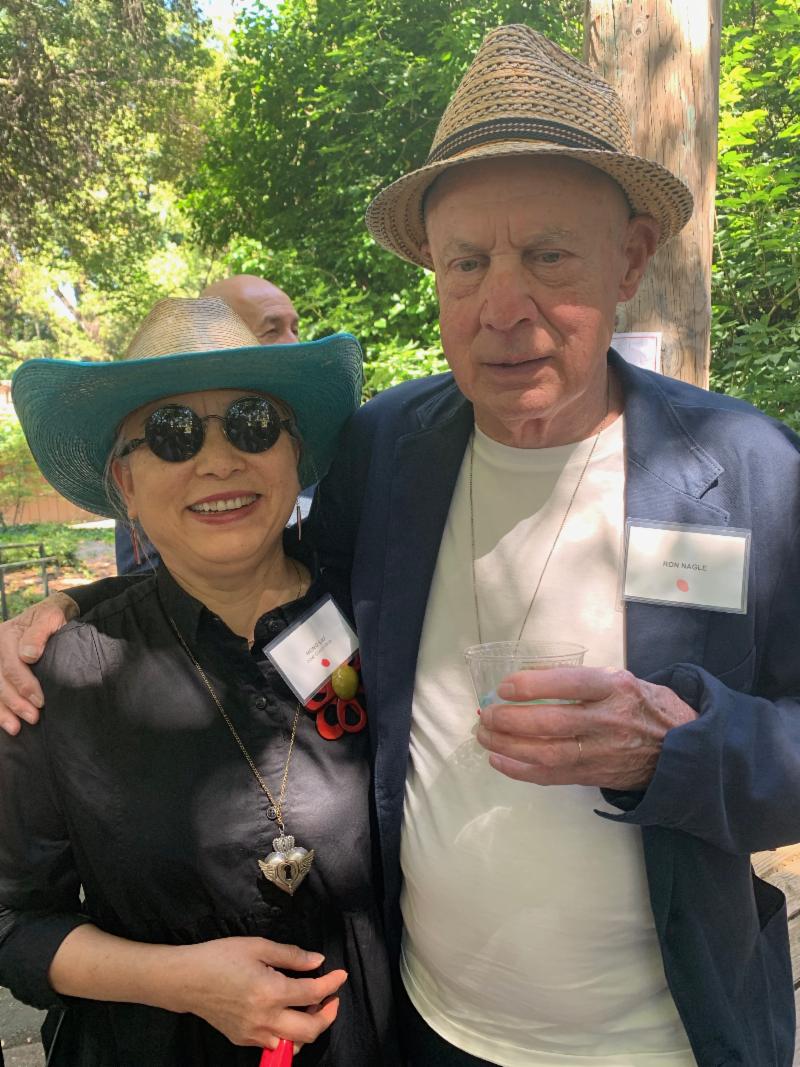 
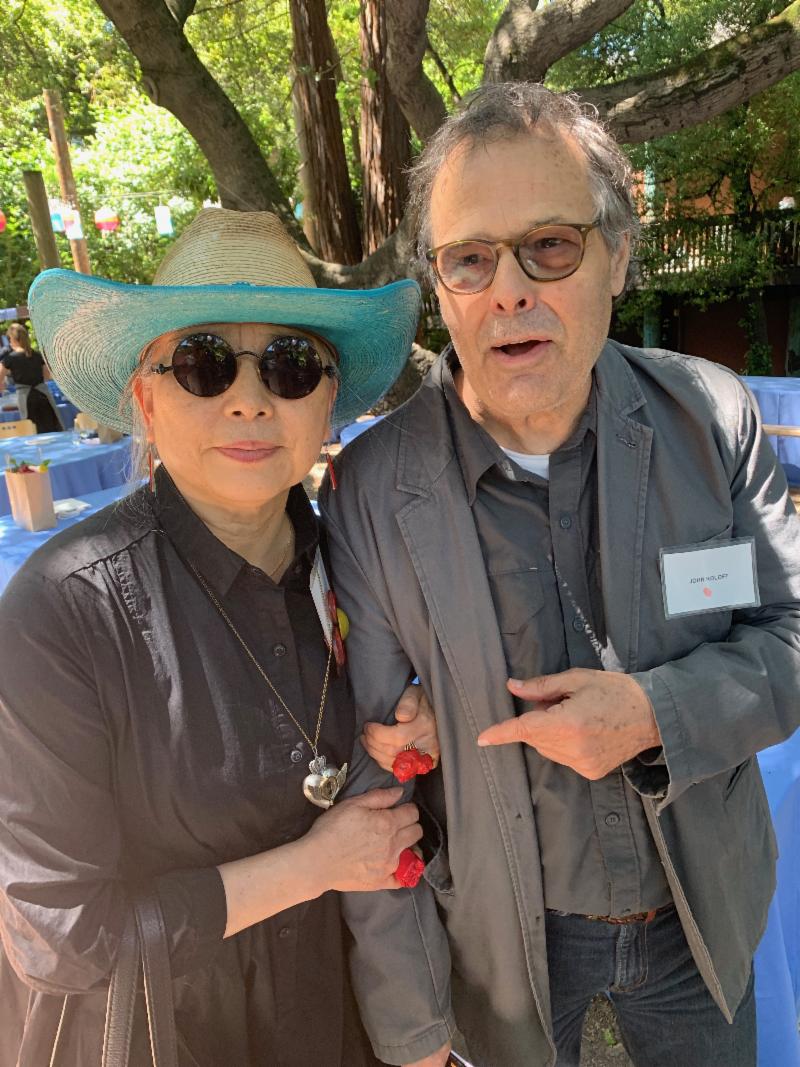 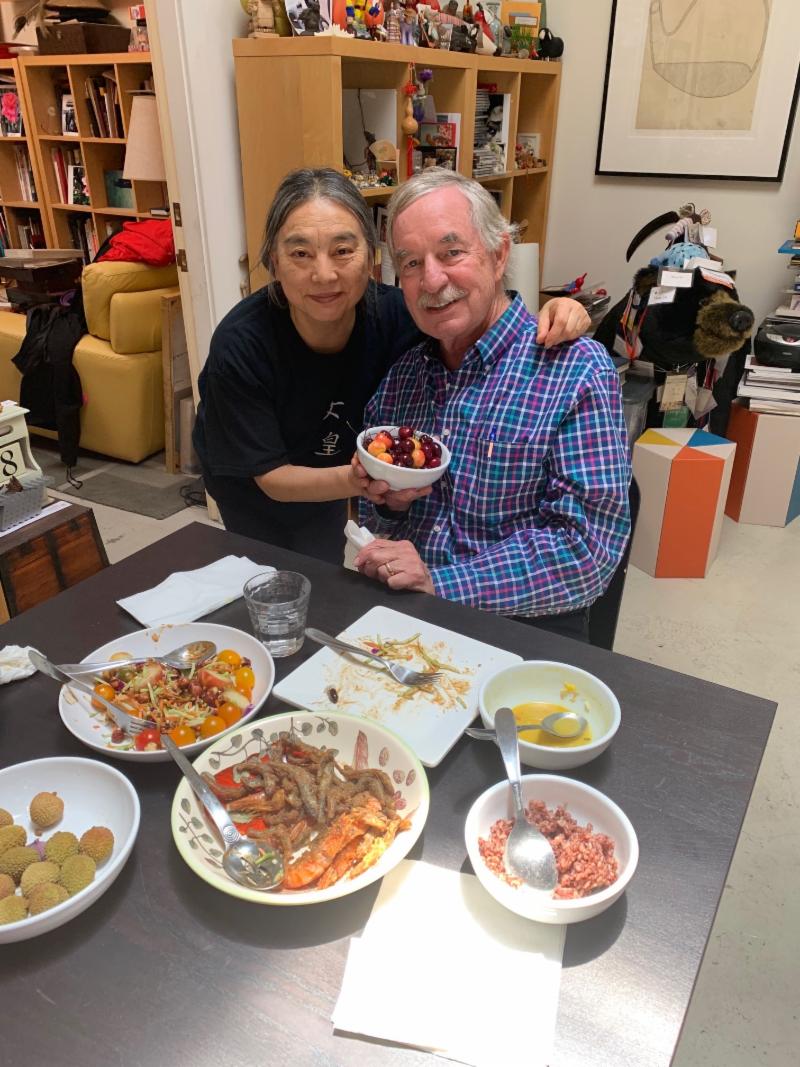
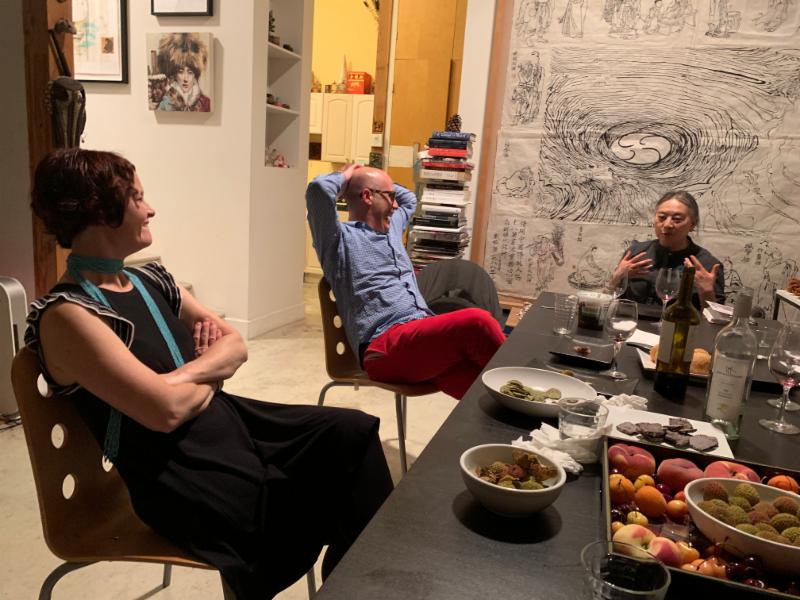 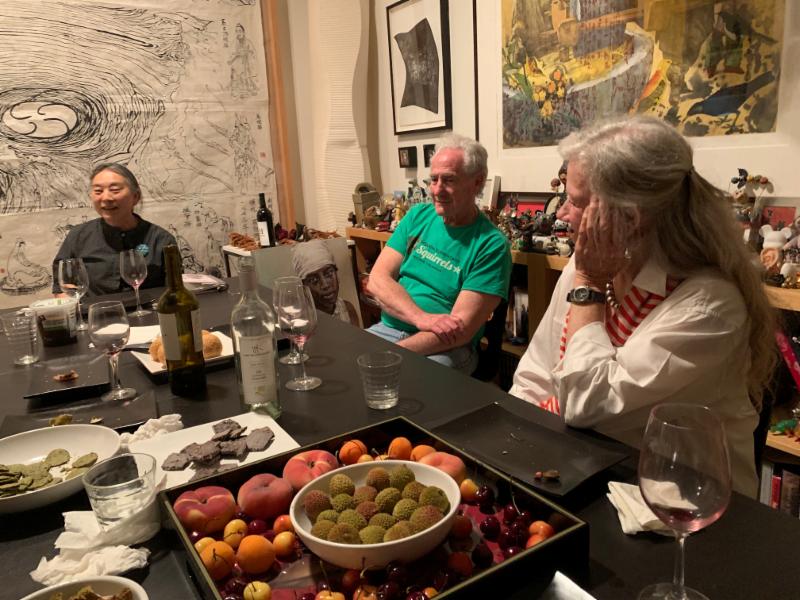
 
Names (L-R, T-B):
Shixuan Luan (UCCA, Beijing), Gary Garrels / Phil Tinari (Director, UCCA, Beijing)
Shixuan Luan / Curator Hou Hanru
Richard Shaw / Monica Lundy, Joie Lee
Jack Wadsworth / Tonya Turner & Michael Carroll, Anne Rose Kitagawa
William Wong, Robin Wu / Wanxiang Zhang
Dancing with Julia White / Julia Goodman & Michael Hall
Katie Mock, Chris Ahn, Larry Mock / Adam Swig & Cissie Swig
Stuart Mason / Josh Roth
Richard Lui (MSNBC) / Amy Pleasant
Walter Maciel, Peter Frank / Frank Lloyd, Wanda Hanson, Paul Schimmel
Julia White, Jenny Bae / Steuart Pittman
Alison Saar / Michael Tilson Thomas
Don Farnsworth, Kara Maria, Enrique Chagoya / Liu Jianhua
Gary Garrels & Richard Hoblock / Roger Mann
Moira Roth & Rory Padeken /
Ling-chi Wang
Larry Rinder & Peter Selz / Ann Wetherell, Ina Asim
Ron Nagle / Mildred Howard
John Roloff / Steve Nash
Ann & Michael Ray / Barry & Mary-Lou Gifford
Bancroft / Leona Street Gobbler Gang
|
John Mason
1927-2019
"He's gone," said the text. It was 7:30 in the morning, still dim outside, dim inside too. Vernita texted me because I was about to fly to San Diego to visit John for the last time. He didn't wait, and stopped breathing at 5:45am.
Normally, Vernita would have been asleep, but rose early this day, went downstairs to John's room - where his hospice bed and caregiver were - asked the caregiver to leave, opened the window blinds to the dawning light, and sat briefly with John, telling him that while people were coming to visit him, he didn't have to wait. She knew he liked to work alone - he always had - and after a few minutes she said goodbye, left the room, and closed the door behind her.
Dying is hard work, but it's necessary work, and, no matter how many friends and family gather 'round us as we pass, dying is always done alone.
Would that it were not so, said the playwright. But alas, so it is. Most of us, I suspect, dread the prospect of dying alone. At that most existential of moments, we hope to hold the hands and lock the eyes of our soulmates, as if something of their souls might come with us, or something of ours might remain. Short of immortality, this may be our fondest dream.

It was not an instinct, Vernita's leaving John to work alone. They'd been married thirty-five years. (I remember - I was best
man at their
wedding in Reno.)
Vernita knew how John worked -
methodically, with a great deal of thought, over time, by himself. Although famously known for having shared a studio with Peter Voulkos, whose personal charisma and Dionysian creative temperament drew the art world to him, John was the Apollonian of the two, rational and well-ordered, methodical. Over a more than six decade career, he researched methods for shaping, methods for cutting, methods for drying and dampening, methods for painting and glazing, for working on the floor, on an easel, on the wall, along the length of a wooden stick, for casting inside of a hollow mold, for slab constructions by hand and rolling pin, by machine rolling, by extruding, and by impact forming. He proceeded systematically toward an idea of something he wanted to see, whether a hand-size X pot, a man-size red "X," a blue wall of clay, or a golden landscape of firebricks. Hand-held or as large as a place, John's art was in his mind before it was in the world. He was, in effect, a classicist, seeking ideal forms in an ancient material.
In time, John's career transcended ceramics, but it modernized clay, turning it into the only mid-century medium besides paint that was truly plastic in that once liberating sense. He saw clay as the most primitive and also the most modern of materials, an earthen slab of space-time awaiting formation.
John was born in Madrid, Nebraska, but took root in Hazen, Nevada, on a farm about forty-five minutes east of Reno. Alfalfa and peach trees were fed by an irrigation ditch that
draw from the nearby Truckee River. Cottonwood trees, always seeming about to die, ran from
the house along the aptly-named Mason Road. Today, Hazen - christened in 1903 as a stop along the Southern Pacific Railroad - is a place you can pass through without knowing it. Traveling east, Hazen and nearby Fallon, where John went to high school, are
the
first places you feel inside the Great Basin, like standing on the slight downhill slope of a vast dusty bowl.
John was sick as a child, coming down with rheumatic fever as a baby and strep as a teenager. Antibiotics were the reason he survived his first eighteen months in Nebraska, and the strep infection in Hazen kept him out of grades nine, ten, and eleven. To the remoteness of the desert and the isolation of illness, modernity was the antidote - especially the radio. John sought to know how things operated in the modern world. The space of Nevada and the time of convalescence had turned John inward while drawing him outward, forming the essential play between the scales of the hand and of the mind - between the ancient past and the modern present - that set the parameters of John's practice as an artist.
 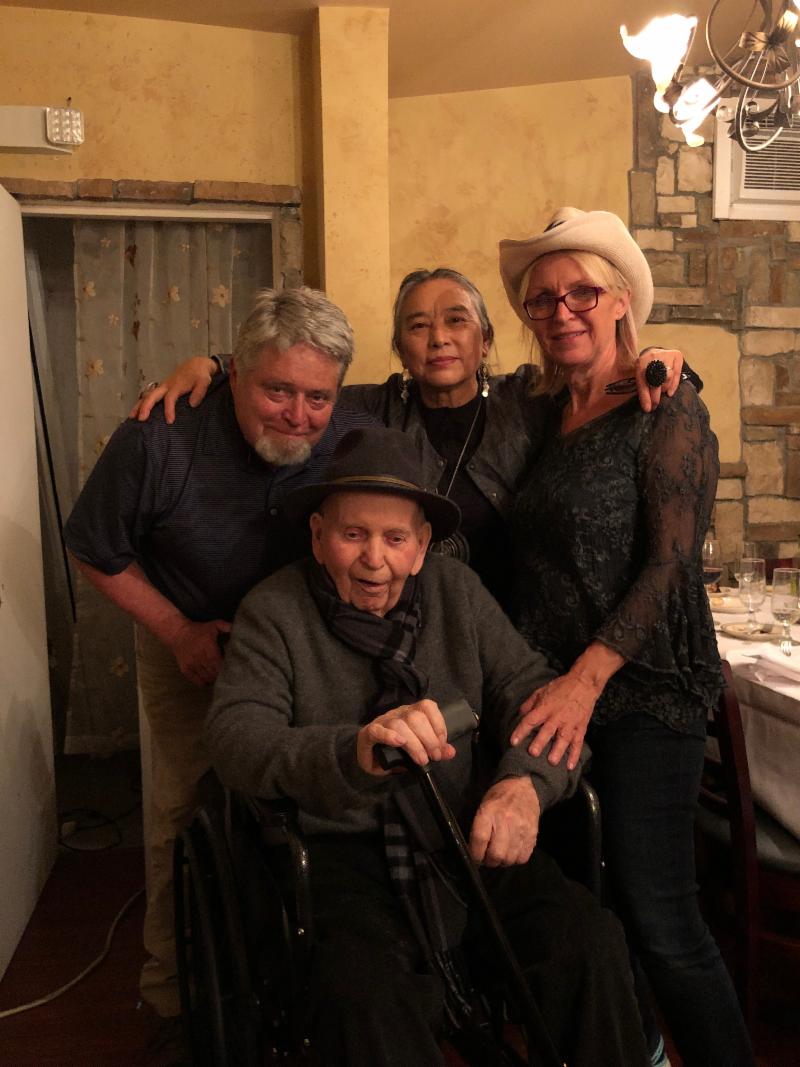
While he preferred to work alone, John was not a solipsist. He had lots of friends and a loyal, steadfast family. He was quietly famous and humbly brilliant. He had the work ethic of a farmer in the desert, and a sometimes impish sense of humor - you could see it in his eyes while he was waiting for you to catch on. He wasn't loquacious, but his verbal timing was perfect. John was always tuned in, but more a receiver than a speaker. You could sit quietly with him for a long time and feel you'd learned something. He was also the most charming of chucklers.

The morning Vernita called me, she offered a series of meaningful coincidences about January 20th. It was, for example, 39 years to the day since her first date with John. Later that evening, the Super Blood Wolf Moon would rise in the western sky for the first time since John Adams was president, and wouldn't come again until the year two-thousand one-hundred and thirteen. Rising at 12:12am Eastern Standard Time, the Super Blood Wolf Moon trans-numerated the date of Jarilyn's (John's daughter's) birthday, which is 12/12.
I pictured the moon over Hazen. John had been interested in astronomy as a boy, and, Hazen being where it is, he had a lot to look at it when the sky grew black. The stars, the deep primeval past, the flicker of modernity too. Movement surrounded by stillness, sounds swallowed-up by silence, the past engulfing the present - and someday the future.
It was raining in Oakland the morning Vernita called. When she reminded me of the evening's coming lunar ascent, I believed I would miss it for the clouds over the bay. But Vernita's perspective was from Encinitas, and her sky was open. Therein, she imagined John aligning the heavens, clearing a passage - not only for himself, but for his family and friends in Southern California, the Bay Area, Utah, and any remaining souls in Hazen.
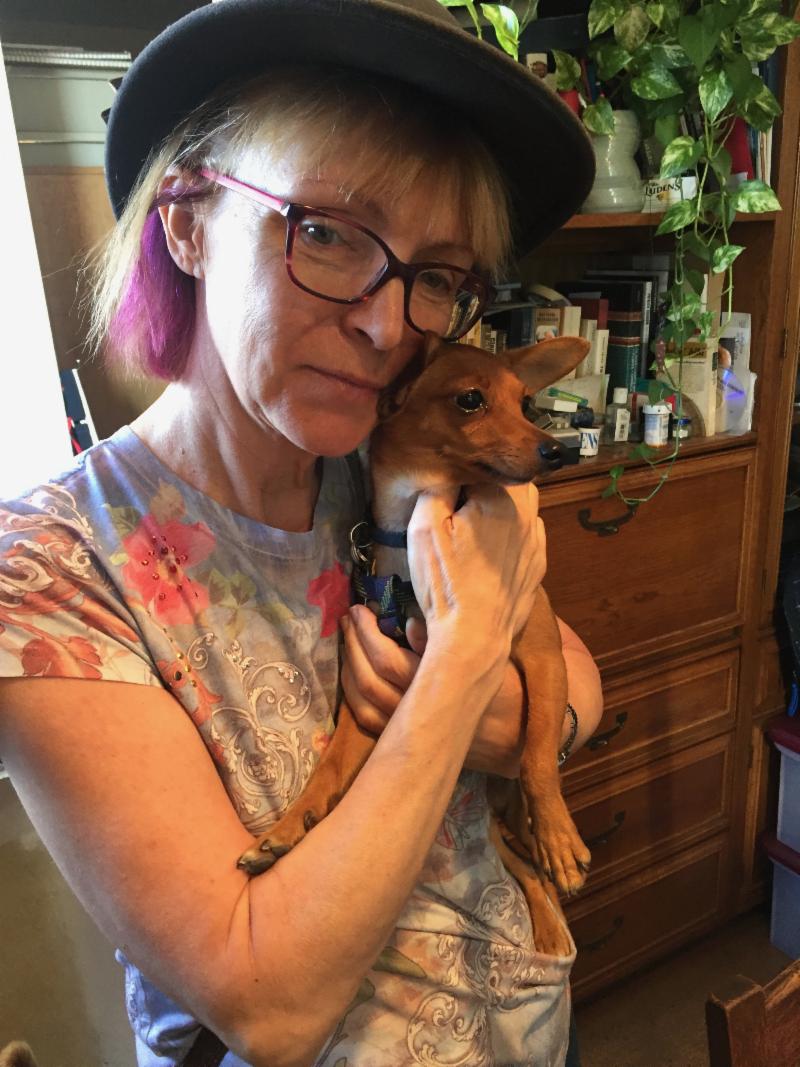
At 5:47pm, twelve hours after John had died, I texted Vernita: "Rainy and overcast up here. Take a picture of John's blood moon for me." At 9:28pm she texted me back: "Ask him to part the clouds and stop the rain for you." I ventured out back. "The rain has stopped," I told her, "and the clouds are moving. [I] see the stars, but no moon yet." "Give him time," she texted. He was working alone. I kept looking, and then my wife called from the front deck - from there, if you looked hard over your shoulder, along the roofline and up past the hill, the Super Blood Wolf Moon appeared, cast in the rusty penumbra of the earth.
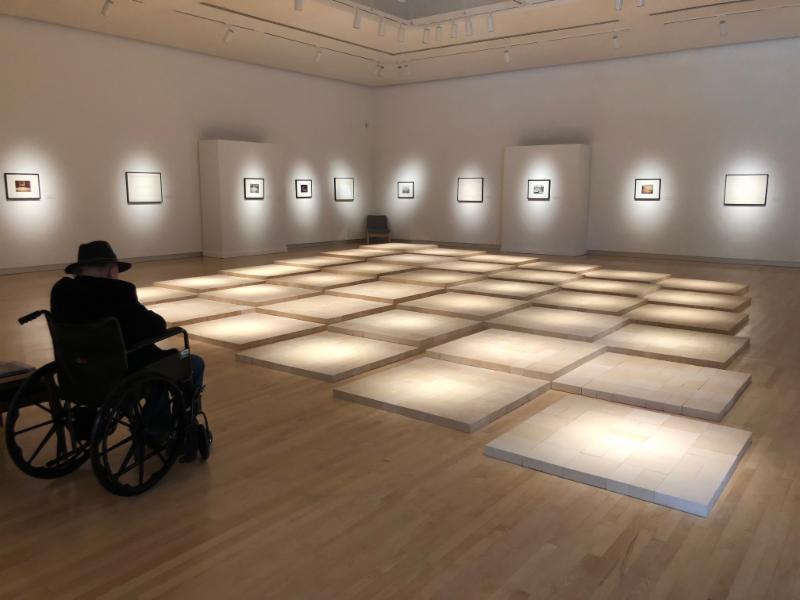
In 1978, John installed a series of modular firebrick floor-pieces across six museums. Collectively known as the Hudson River Series, it rambled from Yonkers to Des Moines, Washington to Minneapolis, and San Francisco to Austin. Though each piece was based on a square, all patterns were different, specific to their museum sites. They were matters of material, geometry, scale, perspective, and light. I have written before that they were the geometry underlying the geography of John's life.
An example is Hudson River Series X Scale 4
, installed in the Corcoran Gallery. Like the proverbial yellow brick road, it ran across three galleries, through two doorways, and beneath ceiling-size skylights. Well over one hundred feet long, this progression of 36-inch blond squares, one and two bricks high, in rooms filled with heavenly light, seemed the expression of infinity. One intuited the complete rotation of modules across the floor, not realizing there were actually two: the single and double brick squares were tumbling in separate if similar rotations. As they meandered into the distance - a considerable distance in any museum - the warm blond squares appeared to rise through the galleries toward the horizon and blend with the radiance of the light. Of all the Hudson River installations, this was the closest to a vision of transcendence.
And so I imagine John Mason in his bed as the dawn breaks outside his window, quietly working, aligning a pathway to eternity, setting rotations in play, activating symmetries, divining through clouds of immense complexity an axis, and - after a lifetime of good work - I imagine him laying back and letting the workings take him. In the space, the breach, the pause, and the final breath between morning's light and the lunar eclipse, a great man took his leave.
Jeff Kelley
March 31st, 2019
The Getty Museum, Los Angeles

When he was a teenager, Peter Selz, a German Jew then living in Munich, visited the most infamous art exhibit of the 20
th
century, "Entartete Kunst," or Degenerate Art. Organized by the Nazi regime, the show consisted of over 650 artworks seized from museum collections and private individuals throughout the Reich. Premiering in Munich on July 19, 1937, "Entartete Kunst" traveled to eleven other cities in the following months - the point being to further inculcate the Volksdeutsche on matters of Aryan superiority by showcasing the degenerate (debased, primitive, ungodly, irrational, sexual, exaggerated, chaotic, dark, and Jewish) art of Modernism. Germans flocked to see it. Peter took the hint and left Germany for New York.
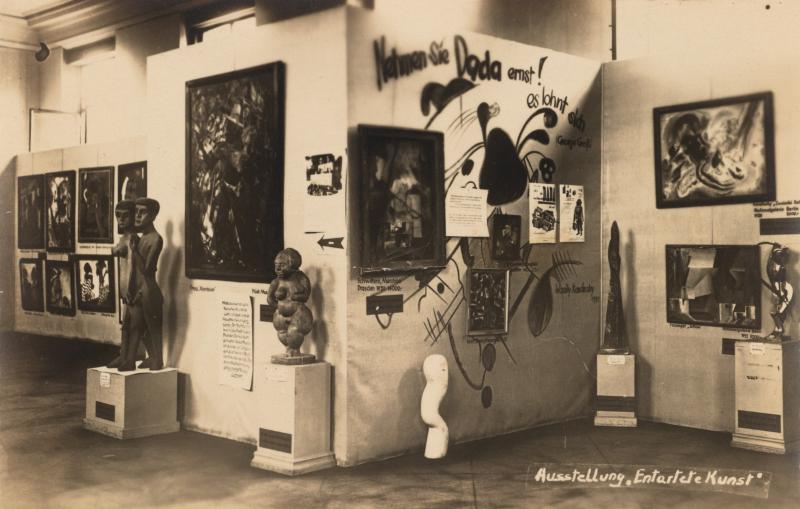
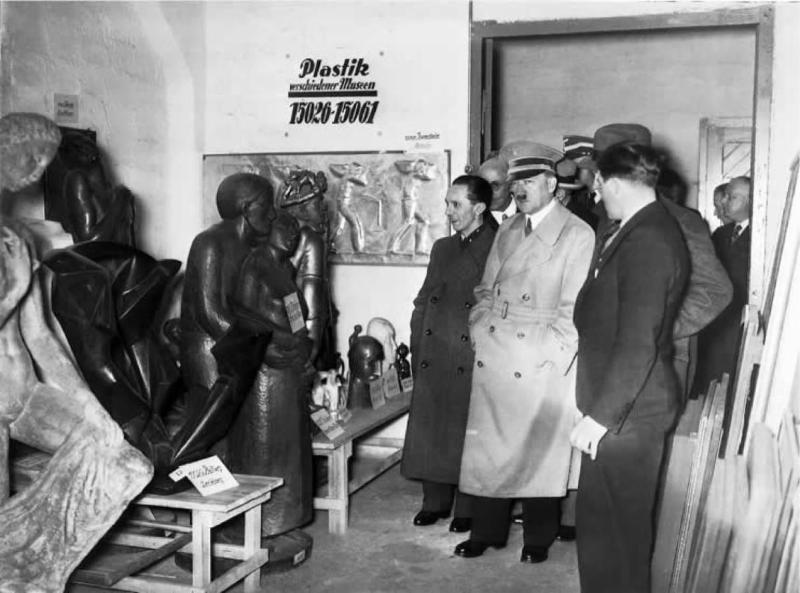 
During the war, Peter served in the OSS, the forerunner of today's CIA, and then studied at the University of Chicago and in Paris. In 1958, he became curator of painting and sculpture at the Museum of Modern Art in New York. While there, he organized major exhibitions by Jean Dubuffet and Alberto Giacometti, as well as August Rodin's first US retrospective. In 1960, he also commissioned Jean Tinguely's infamous self-destroying machine "Homage to New York" (below).
I
n 1965, Peter moved to California to teach art history at Berkeley, soon accepting an invitation to direct and develop the university's art museum, which had just received a gift of fifty works by
Hans Hofmann - still an anchor of its collection today
. Under Peter's leadership, the museum's collection more than doubled in size, and the Pacific Film Archive was formed. He became known for "curating exhibitions which went against current trends," including the controversial and celebrated Funk Show in 1967.
A through line of Peter's career was his commitment to the representation of social justice in art. This came both from his experience of repression in Germany before the War, and from the optimism he sensed in the works of the great 20th century Modernists he championed (many of whom were in "Entartete Kunst").
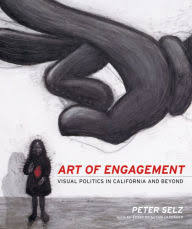 Once, in 1991, at a barbecue that included such art world luminaries as Allan Kaprow, Moira Roth, and Jim Melchert, I asked Peter if - in our (then present) age of cynicism and diminishing expectations - if he was becoming disillusioned about the aesthetic and social values of contemporary art. He pause
d, unable to say for sure. When asked, further, if there had not always been disenchantment among artists, he answered without hesitation: "What distinguished artists of the first half of the 20th century," he asserted, "was their deep belief in the possibility of a better world." As a curator, he was always critical but never cynical. Peter was the best kind of Modernist.
Once, in 1991, at a barbecue that included such art world luminaries as Allan Kaprow, Moira Roth, and Jim Melchert, I asked Peter if - in our (then present) age of cynicism and diminishing expectations - if he was becoming disillusioned about the aesthetic and social values of contemporary art. He pause
d, unable to say for sure. When asked, further, if there had not always been disenchantment among artists, he answered without hesitation: "What distinguished artists of the first half of the 20th century," he asserted, "was their deep belief in the possibility of a better world." As a curator, he was always critical but never cynical. Peter was the best kind of Modernist.
Peter Selz lived to be 100 years old, passing away on June 21st, 2019. In the last five years, he - together with Sue Kubly - curated two shows of Hung's work: "Hung Liu: Daughter of China, Resident Alien," 2016, at the Katzen Center Museum at American University in Washington, DC; and "Daughters of China," 2017, at KALA Art Institute in Berkeley. In each case, he was fully engaged in selecting the work, participating in panel discussions, and even traveling to Washington for the Katzen opening.

Early on, he interviewed Hung about her life and work at his famous modern home in Berkeley. From my perspective, the interview had been disjointed and off-topic; I thought they should do it again. Peter, however, thought he and I should talk, so we set a date. But like Abbot & Costello doing "Who's on First," Peter & I couldn't figure out the interview - since he thought he was interviewing me, and I thought I was interviewing him. When we finally realized that we were vying to interview each other, we laughed heartily at how obtuse we both were.
Still, something magical happened, as it always did with Peter:
Jeff: Well, let me ask you a couple of questions, Peter. So, one of them has to do with immigration. As you mentioned earlier, you are ...
Peter: I was a refugee.
Jeff: ... and Hung's not a refugee, although it can be argued that she felt like one since in order to be an artist of any significance she would have to leave China.
Peter: She would have to leave, yeah.
Jeff: But, given that you're a refugee from ...
Peter: From Nazi Germany.
Jeff: ... Nazi Germany. I would say she's an expatriate as well as an immigrant. I mean, when you think of it from an American point of view, she's an immigrant, but from a Chinese point of view she went away. My question to you, Peter, is ... How do you identify with her migratory experience of coming to the US? Or is that something that you do identify with?
Peter: Well, in a way I do identify with this because, you know, she left her country, she left her soil, her language - the same thing had happened to me. I was much younger than she when I came to this country. I was only 17 years old. I wasn't totally formed, but I had already very strong political convictions which way back then were on the left, as they are now, so in many ways I identify with this and also her work relates to Chinese history and to my work, my dissertation. I did my first book on German Expressionism, which relates to German history the way the Daughters of Chinarelate to Chinese history.
Jeff: Do you think that her Daughters of Chinapaintings are a little bit reminiscent of German Expressionism in terms of the drama with which they're painted?
Peter: Oh, yeah. Definitely reminiscent. I mean, in Germany there'd be more distortion of the figures in Expressionist paintings ...
Jeff: Right.
Peter: ... because they try to stay away from realism, but the drama of it is very much related - the political drama.
Jeff: Yeah, and maybe even some sense of intensified color.
Peter: Oh, yeah. Oh, absolutely it is.
Jeff: Because the thing about Hung that nobody ever thinks about is that all of the photographs (or films) that she worked from are all black and white.
Peter: Yeah.
Jeff: But her paintings are all in color and sometimes it's quite vivid and very rich and organic, so her palette gets made up from her memory or the way she's feeling in the studio - the color just comes out of her head while she's painting. Now, a question that I know she'd be interested in asking you is, aside from the subject matter of her paintings, you know, is whether you think she's a good painter and, if so, why?
Peter: Well, that's a very good question. [chuckles] Why is somebody a good painter? I think it's a combination of things. It's a combination of inventions. Even though these paintings relate to history and to actual facts in the past, Old Gold Mountain was something else - I mean, the inventiveness, this is what really first turned me onto her work. I had never seen anything like that installation. For 50 years, nothing like this has been done quite the same way. And I think it's that kind of innovation that matters. And as far as the paintings are concerned, I mean, it's extremely well painted, and maybe going back to her training in Socialist Realism, but you don't find much painting these days that is such a dexterous combination of pictorial ability and mythic drama.
Nor do you find many art historians dexterous enough to have internalized a century of history and the art that engaged it. He was a great man.
Farewell Herr Professor...
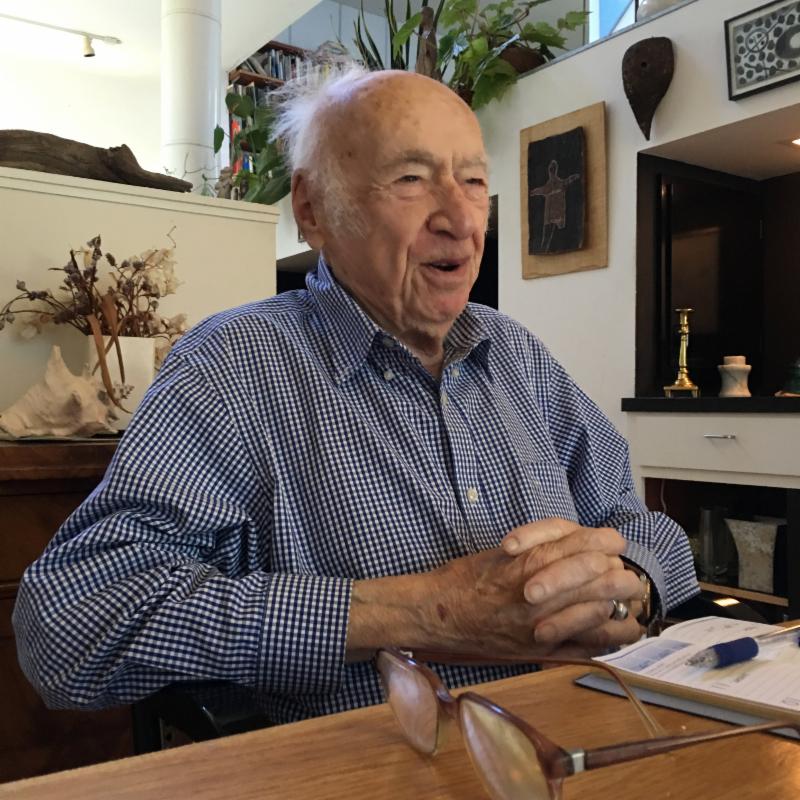
David Salgado
1949-2018

Hung
Liu worked with David Salgado of Trillium Graphics for about 15 years. Like all artist / master printer relationships, theirs involved a collaborative exchange in which the master printer helps to facilitate a vision the artist may not know how to achieve in print and mixed media. He helped her make art by other means.
Seeing the layering of historical imagery, epic narratives, photography, painting, and persona
l experience in Hung's work, David devised a technique that allowed for a degree of transparency
theretofore unseen i
n her paintings.
He did this by framing layers of digital imagery (from Hung's oil
paintings, from traditional Chinese art, and from revolutionary Chinese propaganda), gold and silver leaf, and amber-like resin into two dimensional works that were essentially new kinds of paintings.
Upon these, Hung painted freely, breathlessly, across a resin surface - Salgado often commented that at Trillium her hand was skating. Known as Za Zhong (bastard paintings), David referred to these works as "the bastard children of painting and printmaking."
Salgado's approach allowed the artist to draw upon her own work from over the last five decades, selecting particular images or painterly passages and digitally weaving them together into new works based on her customary sources.
David's death in late 2018 reminds us that artists are not often loners fixed upon an axis that extends from the mind to the eye to the hand and the canvas. Rather, they work collaboratively with other creative people who help them to see what they need to see in some unexpected way. David's passion pushed Hung's work into dimensions of transparency her work had never embodied.
Despite David's passing, Trillium Graphics carries on, and both Hung and the staff gather up years of experience and continue experimenting with and producing these elegant Bastard Paintings.
All respect for pioneer David Salgado...
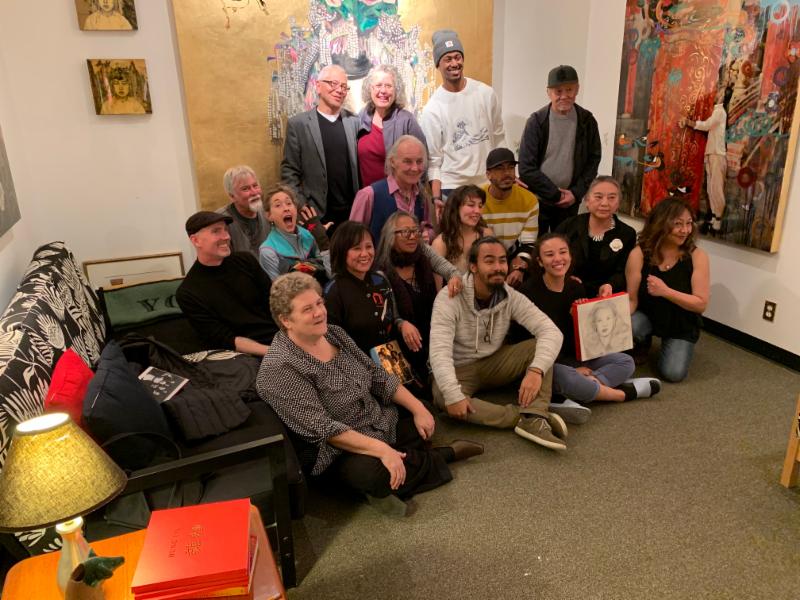
|
|
|
At David's memorial service, Trillium Graphics
|
|
Catchers
Turner Carroll Gallery, Santa Fe, NM
Opening July 10, 2019
Spare Tire
Nancy Hoffman Gallery, New York
Opening October 24, 2019
Passerby
Ullens Center for Contemporary Art, (UCCA)
798 Art Zone, Beijing
Opening December 6, 2019
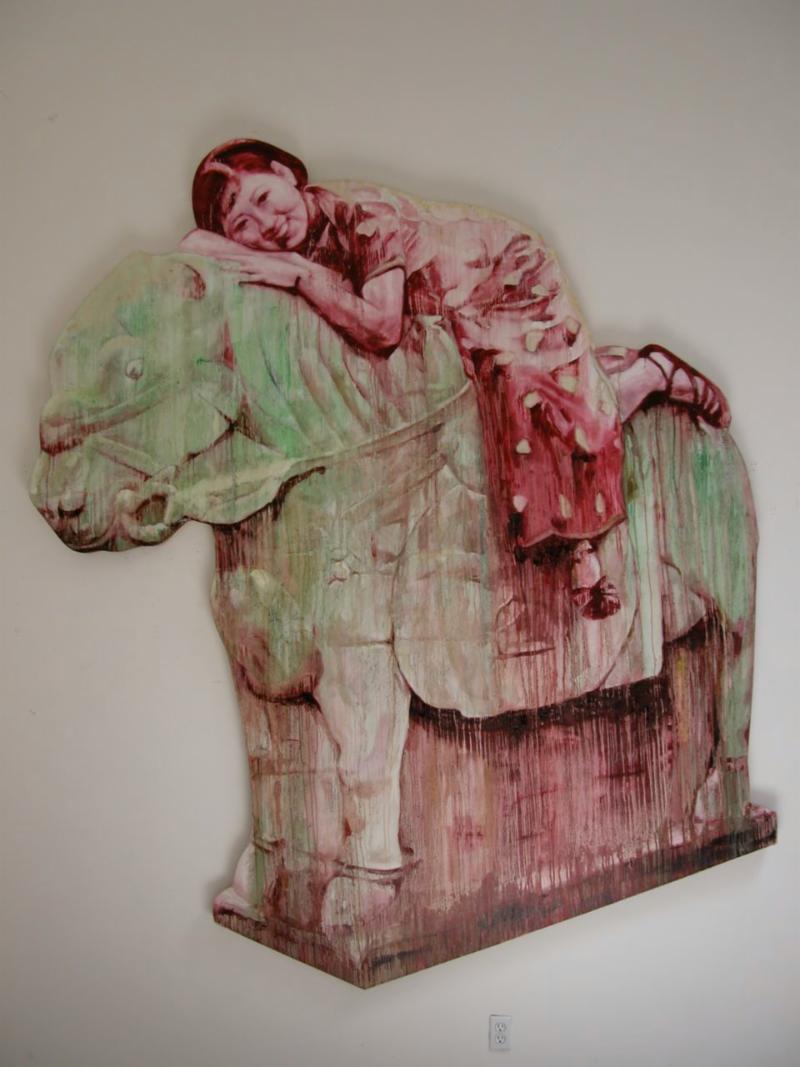
|
|
| |
|
Los Angeles Times
"In her new work, from 2015 to the present, (Hung) Liu draws upon the photographs of Dorothea Lange (1895-1965). This marks a significant change of subject matter and sourcing for Liu, since Lange is American. It also fundamentally alters the nature of the work." - Leah Ollman
San Francisco Chronicle
"Hung Liu, who's had shows all over the country and spoke at the Minnesota Street Project on Saturday, about 'Women Who Transformed Art in the West,' had been the center of attention the night before at the opening of 'All Over the Map,' a show at the Sanchez Art Center in Pacifica. In these works, curated by Phil Linhares and created with David Salgado at Trillium Press, the artist combines fragments of paintings with photos and historical materials, and embeds them in layers of translucent material, on top of which she paints. It's a complex art form, the results seeming old and new at once." - Leah Garchik
Square Cylinder
"As the public reckons with the necessity of supporting and defending women against male aggression, there is a dizzying prescience in these emotionally gripping images of armed women pushed to the very limits of their endurance." - Nick Stone
Berkeleyside
"It would be hard to imagine an art exhibition more relevant to current events, or one more visually and emotionally stirring, than Daughters of China, the stunning show of monumental oil paintings by East Bay-based artist Hung Liu." -Marcia Tanner
Reporter-Herald
"Liu chose the cookies to represent the gold that drew the immigrants to the West Coast. 'That is also a metaphor of coming to America to seek your fortune, but there is a twist and it's important to know. The twist is the Chinese did not invent fortune cookies,' Kelley said." - Michelle Vendegna
Square Cylinder
"Had Liu stuck to her early training in Socialist Realist and not gotten an American education that permitted and encouraged free expression, the paintings we see here would not, stylistically speaking, have been possible. That the best of them significantly departs from their sources lends double meaning to the titled Promised Land, alluding to both the better life sought by the migrants Lange pictured, and to the stories career Liu achieved after arriving on these shores in 1984 with $20 and a suitcase" - David Roth
San Francisco Chronicle
"The Lange photographs have become so well-known that the people in Liu's paintings seem like old friends, their familiar features recaptured in new portraits and images. It's as though the photographer and her work have been reborn. The Oakland Museum has the Lange archives, and Liu has spent much time there immersed in that work, 'and I talk with her all the time'." - Leah Garchik
San Francisco Chronicle
"It's an artistic risk to take a famous Dorothea Lange picture from the Great Depression and turn it into an oil on canvas. But in the translation, Jung Liu is able to bring unique empathy to Lange's Dust Bowl images, having spent four years working the fields during the Cultural Revolution in People's Republic of China" - Sam Whiting
Huffington Post
"Although some may interpret this work's focus on the American Dust Bowl migration a departure from previous work because the subjects are not Chinese, Liu insists that this new work is not a pivot, but a natural extension of her previous work." - Amy Pleasant
Fresno Bee
"One of the great things about her new Fresno exhibition is the way you can flit back and forth between her earlier days as a student - absorbing the furtive freshness and raw vitality of a rural Beijing - with some of her much more politically pointed works. One of the biggest and most impressive, titled "Modern Time," is based on a banal photograph of a woman daydreaming in a conference room. On the wall behind her are four photographs that used to be found on the walls of schools and public buildings across China: the "four white guys" who helped birth the communist ideology. But Liu offers a subversive twist. She depicts Marx, Engels, Lenin and Stalin in the style of Van Gogh, giving a post-Impressionist hint of snark to the scene." - Donald Munroe
Huffington Post
"A recent visit to the Palm Springs Museum affirms for me that all artists are immigrants. If not in a literal sense then in a figurative sense, they are strangers to the society surrounding them. In the desert resort city, populated by celebrities in steel houses, the local museum is exceptional. At the moment, it has exhibits by both Ai Wei Wei, the Chinese dissident renowned the world over, as well as Hung Liu, a professor of painting from China who has become a citizen of America." - Frank H. Wu
Washington Post
"The centerpiece of that show, Hung Liu's "Daughter of China, Resident Alien," is a pile of some 200,000 fortune cookies atop tracks that evoke the role of Chinese labor in building American railways. In a large painting based on the artist's green card, she takes the name "Cookie, Fortune." Many of Liu's paintings are derived from photos or propaganda-film stills and dissolve realism into abstraction to represent the evaporation of Marxist-Leninist China and her memories of it." - Mark Jenkins
UCSD Visual Arts Department link:
Los Angeles Times
"Her new paintings are portraits of the most humble of flowers - dandelions - and they are spectacular." - Sharon Mizota
Kansas City Star
In "Summoning Ghosts" at the Kemper Museum of Contemporary Art, Chinese-born artist Hung Liu quite literally "summons ghosts," bringing the dead and willfully forgotten into our view through large paintings based on 19th and 20th century photographs taken in China. - Neil Thrun
KQED Radio
Confined in China, Ai Weiwei Directs Alcatraz Exhibit from Afar (Hung Liu interviewed), Mina Kim, September 27, 2014. "Painter Hung Liu is close friends with Ai. Liu grew up during China's Cultural Revolution under Mao Tse-Tung, and like Ai, China's politics and culture infuse her work. She is wary of political art becoming too didactic. 'When you have a strong political agenda, a strong message, you have to be careful if you want to use art form,' the painter says. Liu says she plans to take a serious look at Ai's Alcatraz work, and hopes others will get past his superstar status and do the same.
'Ai Weiwei's super-famous. Some people call him God Ai -
Ai shen
,' Liu says. 'I think it's little too far.'
It's important for people to continue to think critically about Ai's work, Liu says - after all, people tried to make Mao a god, too." - Mina Kim
SF Chronicle
Many contemporary painters struggle to get history into their work without looking pretentious or ideologically motivated. But big events of the late 20th century weighed so heavily on the life of Oakland painter Hung Liu that she might have found it difficult to keep history out of her work.
- Kenneth Baker
Square Cylinder
It's easy to marvel at how Liu's mix of abstraction and realism draw us into the past. Yet virtuosity alone doesn't explain the emotional pull of her painting. So I'll venture a theory: Since Liu works from photos, her painting process is analogous to the photochemical act of "fixing" an image in the darkroom from which pictures seemingly emerge out of nowhere. Liu performs a kind of psychic translation of that act, supplementing it with lived experience and an extraordinary level of empathy. Result: she can paint from photos and literally "summon ghosts."
- David Roth
KQED Radio
Hung Liu is good at summoning ghosts -- from memory and history. She's an Oakland artist born in China, and "Summoning Ghosts" is the title of a new retrospective of her work at the Oakland Museum of California.
- Cy Musiker
Art-Rated
Hung Liu is widely considered one of the most important Chinese artists working in America today.
- Interview by Rachelle Reichert
Art Practical
The spare aesthetic of the exhibition currently on view at the Mills College Art Museum belies the fullness of the Bay Area artist and educator Hung Liu's major concern: history.
- Ellen Tani
Art Practical
In February 1948, the artist Hung Liu was born in Changchun, in the far north of China. Only months later, the city was the site of a major siege by the People's Liberation Army.
- Matthew Harrison Tedford
Contra Costa Times
She's internationally known for her dramatic paintings, which often layer historical images with scenes from her own life or those of everyday people who didn't make it into the history books.
- Angela Hill
San Francisco Chronicle/SFgate
In the early 1970s, Hung Liu, who was being trained in the strict Social Realist style required of Chinese artists at the time, surreptitiously made small landscape paintings that contained no images of Chairman Mao, heroic soldiers or happy peasants. She hid them under her bed to dry.
- Jesse Hamlin
|
|
Publications (Warm off the Press)
|
|
|
|
|
Zoetrope: All Story
Frances Ford Coppola's Literary Magazine
Winter 17/18, Volume 21
|
Hung Liu: Promised Land
Essay by Maria Porges
Rena Bransten Gallery/Hung Liu Studio, 2017
Catalogues available
(Cool off the Press)
|
|
|
Hung Liu: American Exodus
Introduction by Lori Fogarty
Essays by John Yau & Drew Johnson
Interview by Rachelle Reichert
Nancy Hoffman Gallery/Hung Liu Studio, 2016
Catalogues available
|
|
|
|
Hung Liu: Scales of History
Essay by Jeff Kelley
Fresno Art Museum/Hung Liu Studio, 2016
Catalogues available
|
|
|
Hung Liu: Daughter of China, Resident Alien
Essay by David Pagel; Conversation between Peter Selz & Jeff Kelley
American University Museum, Katzen Center, Washington DC/Hung Liu Studio, 2016
Catalogues available
|
|
|
|
Hung Liu: Questions from the Sky
Ed Hardy, Susan Krane
Hahrdymarks Press, 2015
|
Chinese Contemporary Art
Wu Hung
Thames & Hudson
2014
 |
|
Qianshan: Grandfather's Mountain
|
Interview by Rachelle Reichert
Nancy Hoffman Gallery, 2013
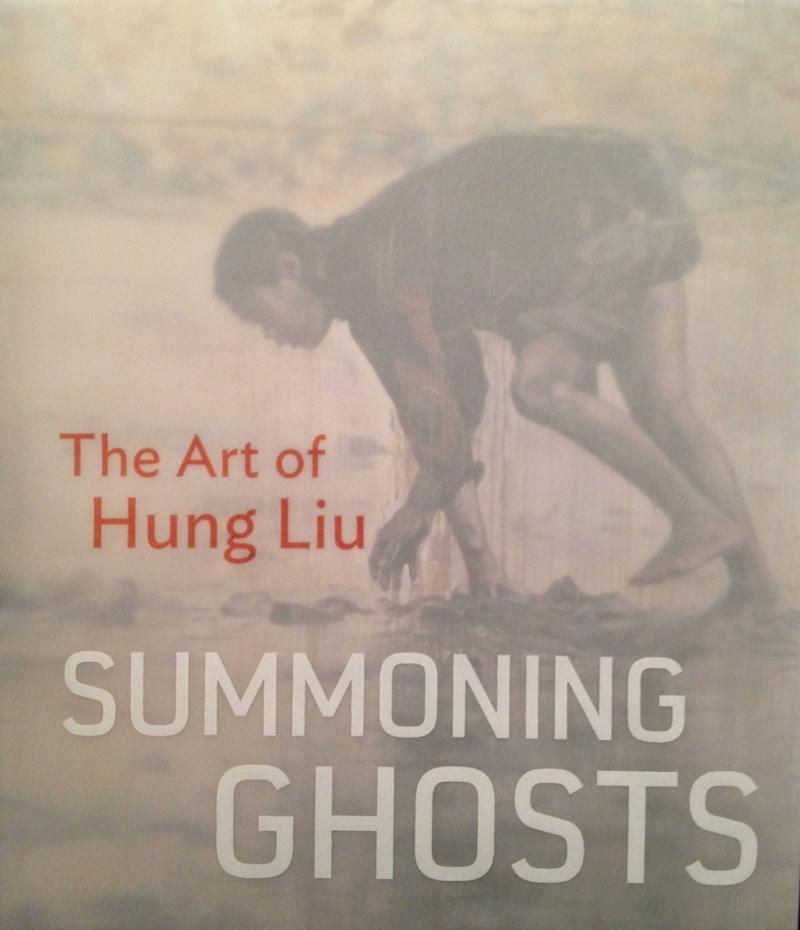 |
|
Summoning Ghosts: The Art of Hung Liu
|
Essays by Wu Hung, Yiyun Li, Rene De Guzman, Karen Smith, Stephanie Hanor, Bill Berkson
216 pages,
Oakland Museum of California & The University of California Press
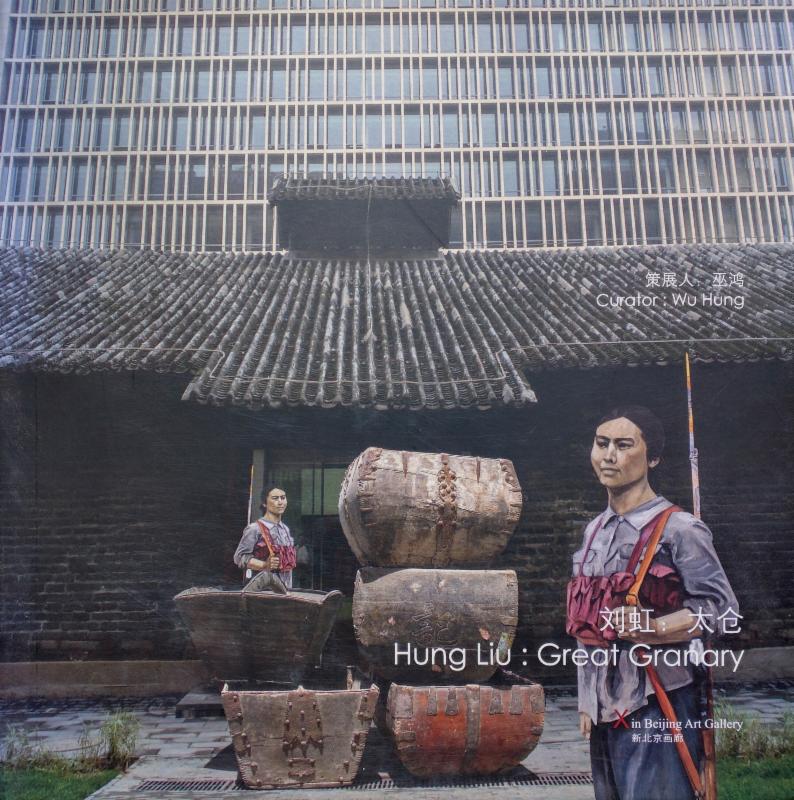
Hung Liu: Great Granary
Essay & Interview by Wu Hung
Xin Beijing Art Gallery / Timezone 8 Press
Available through Hung Liu Studio
|
Thank You!
Hung Liu Studio |
|
|
|